Multi-Input Modeling Approach to Assess the Impacts of Climate Change on Grand Inga Hydropower Potential
Abstract
1. Introduction
2. Grand Inga—Overview and Project Planning
2.1. Overview on Inga Falls
2.2. Development Prospects of Grand Inga
3. Data and Methods
3.1. Modelling Procedure
3.2. Data
3.2.1. System Data for Inga Falls Hydropower Development
3.2.2. System Data
3.2.3. Future Climate Projection Data
3.2.4. Differences and Connections Between CMIP6 and CMIP5
3.3. Hydrological Model
3.4. Model Calibration
3.5. Multi-Input Ensemble Modelling
3.6. Simulations of Hydropower Generation
3.6.1. Hydropower Model Application
3.6.2. Steps of the Hydropower Generation Simulation Project
- Define the hydropower model for existing and prospective developments in Inga Falls.
- Generate power from observed flow from 1981 to 2000 (Baseline, 1 Run).
- Generate power from flow data acquired from 13 Climate models for 1981–2000 (13 runs).
- Produce generation from future flow data under two main climate modeling scenarios: CMIP5 and CMIP6, each involving different models, RCP/SSP scenarios, and time frames, leading to 65 different runs per scenario.
- Compile summary results for all models and emission scenarios.
4. Results and Discussion
4.1. Hydrological Modelling
4.2. Projected Hydrologic Scenario
4.3. Hydropower Generation Simulations
4.3.1. Flow Duration Curve
4.3.2. Water Utilization Duration Curve
- Minimum flow (3700 m3/s)—Highest Priority.
- Units in Phase 1—Second Priority.
- Units in Phase 2—Third Priority.
- Units in Phases 3 to 8—Decreasing Order of Priority.
4.3.3. Hydropower Generation from Observed Flow 1981–2000
4.3.4. Hydropower Generation from Each Future Simulation
Hydropower Generation from CMIP5 Scenarios
Hydropower Generation from CMIP6 Scenarios
Hydropower Generation from CMIP5 and CMIP6 Scenarios Beyond Inga 8
5. Conclusions
Author Contributions
Funding
Data Availability Statement
Acknowledgments
Conflicts of Interest
References
- Qin, P.C.; Xu, H.M.; Liu, M.; Du, L.M.; Xiao, C.; Liu, L.L.; Tarroja, B. Climate change impacts on Three Gorges Reservoir impoundment and hydropower generation. J. Hydrol. 2020, 580, 123922. [Google Scholar] [CrossRef]
- Huntington, T.G.; Weiskel, P.K.; Wolock, D.M.; McCabe, G.J. A new indicator framework for quantifying the intensity of the terrestrial water cycle. J. Hydrol. 2018, 559, 361–372. [Google Scholar] [CrossRef]
- Syed, T.H.; Famiglietti, J.S.; Chambers, D.P.; Willis, J.K.; Hilburn, K. Satellite-based global-ocean mass balance estimates of interannual variability and emerging trends in continental freshwater discharge. Proc. Natl. Acad. Sci. USA 2010, 107, 17916–17921. [Google Scholar] [CrossRef] [PubMed]
- Loaiciga, H.A.; Valdes, J.B.; Vogel, R.; Garvey, J.; Schwarz, H. Global warming and the hydrologic cycle. J. Hydrol. 1996, 174, 83–127. [Google Scholar] [CrossRef]
- Cui, T.; Tian, F.Q.; Yang, T.; Wen, J.; Khan, M.Y.A. Development of a comprehensive framework for assessing the impacts of climate change and dam construction on flow regimes. J. Hydrol. 2020, 590, 125358. [Google Scholar] [CrossRef]
- Fluixá-Sanmartín, J.; Altarejos-García, L.; Morales-Torres, A.; Escuder-Bueno, I. Climate change impacts on dam safety. Nat. Hazards Earth Syst. Sci. 2018, 18, 2471–2488. [Google Scholar] [CrossRef]
- van Oorschot, M.; Kleinhans, M.; Buijse, T.; Geerling, G.; Middelkoop, H. Combined effects of climate change and dam construction on riverine ecosystems. Ecol. Eng. 2018, 120, 329–344. [Google Scholar]
- Ehsani, N.; Vörösmarty, C.J.; Fekete, B.M.; Stakhiv, E.Z. Reservoir operations under climate change: Storage capacity options to mitigate risk. J. Hydrol. 2017, 555, 435–446. [Google Scholar] [CrossRef]
- IPCC. Climate Change 2014–Impacts, Adaptation and Vulnerability: Part A: Global and Sectoral Aspects: Volume 1, Global and Sectoral Aspects: Working Group II Contribution to the IPCC Fifth Assessment Report; Cambridge University Press: New York, NY, USA, 2014. [Google Scholar]
- Berga, L. The Role of Hydropower in Climate Change Mitigation and Adaptation: A Review. Engineering 2016, 2, 313–318. [Google Scholar] [CrossRef]
- Wasti, A.; Ray, P.; Wi, S.; Folch, C.; Ubierna, M.; Karki, P. Climate change and the hydropower sector: A global review. Wires Clim. Change 2022, 13, e757. [Google Scholar] [CrossRef]
- Hamududu, B.; Killingtveit, A. Assessing climate change impacts on global hydropower. In Climate Change and the Future of Sustainability; Apple Academic Press: Palm Bay, FL, USA, 2017; pp. 109–132. [Google Scholar]
- Lu, S.; Dai, W.; Tang, Y.; Guo, M. A review of the impact of hydropower reservoirs on global climate change. Sci. Total Environ. 2020, 711, 134996. [Google Scholar] [CrossRef] [PubMed]
- Nohara, D.; Kitoh, A.; Hosaka, M.; Oki, T. Impact of climate change on river discharge projected by multimodel ensemble. J. Hydrometeorol. 2006, 7, 1076–1089. [Google Scholar]
- Chilkoti, V.; Bolisetti, T.; Balachandar, R. Climate change impact assessment on hydropower generation using multi-model climate ensemble. Renew. Energy 2017, 109, 510–517. [Google Scholar]
- Turner, S.W.D.; Ng, J.Y.; Galelli, S. Examining global electricity supply vulnerability to climate change using a high-fidelity hydropower dam model. Sci. Total Environ. 2017, 590–591, 663–675. [Google Scholar]
- van Vliet, M.T.H.; Wiberg, D.; Leduc, S.; Riahi, K. Power-generation system vulnerability and adaptation to changes in climate and water resources. Nat. Clim. Change 2016, 6, 375–380. [Google Scholar]
- Zhou, Y.; Hejazi, M.; Smith, S.; Edmonds, J.; Li, H.; Clarke, L.; Calvin, K.; Thomson, A. A comprehensive view of global potential for hydro-generated electricity. Energy Environ. Sci. 2015, 8, 2622–2633. [Google Scholar]
- Liu, L.-L.; Du, J.-J. Documented changes in annual runoff and attribution since the 1950s within selected rivers in China. Adv. Clim. Change Res. 2017, 8, 37–47. [Google Scholar] [CrossRef]
- Liu, L.; Xu, H.; Wang, Y.; Jiang, T. Impacts of 1.5 and 2 °C global warming on water availability and extreme hydrological events in Yiluo and Beijiang River catchments in China. Clim. Change 2017, 145, 145–158. [Google Scholar]
- Schaefli, B. Projecting hydropower production under future climates: A guide for decision-makers and modelers to interpret and design climate change impact assessments. Wiley Interdiscip. Rev. Water 2015, 2, 271–289. [Google Scholar]
- Chen, J.; Brissette, F.P.; Poulin, A.; Leconte, R. Overall uncertainty study of the hydrological impacts of climate change for a Canadian watershed. Water Resour. Res. 2011, 47, W12509. [Google Scholar] [CrossRef]
- Wilby, R.L. Uncertainty in water resource model parameters used for climate change impact assessment. Hydrol. Process. 2005, 19, 3201–3219. [Google Scholar]
- Ludwig, R.; May, I.; Turcotte, R.; Vescovi, L.; Braun, M.; Cyr, J.F.; Fortin, L.G.; Chaumont, D.; Biner, S.; Chartier, I.; et al. The role of hydrological model complexity and uncertainty in climate change impact assessment. Adv. Geosci. 2009, 21, 63–71. [Google Scholar]
- Poulin, A.; Brissette, F.; Leconte, R.; Arsenault, R.; Malo, J.-S. Uncertainty of hydrological modelling in climate change impact studies in a Canadian, snow-dominated river basin. J. Hydrol. 2011, 409, 626–636. [Google Scholar]
- Minville, M.; Brissette, F.; Leconte, R. Impacts and Uncertainty of Climate Change on Water Resource Management of the Peribonka River System (Canada). J. Water Resour. Plan. Manag. 2010, 136, 376–385. [Google Scholar]
- Blöschl, G.; Montanari, A. Climate change impacts—Throwing the dice? Hydrol. Process. Int. J. 2010, 24, 374–381. [Google Scholar] [CrossRef]
- Christensen, N.S.; Lettenmaier, D.P. A multimodel ensemble approach to assessment of climate change impacts on the hydrology and water resources of the Colorado River Basin. Hydrol. Earth Syst. Sci. 2007, 11, 1417–1434. [Google Scholar]
- Kopytkovskiy, M.; Geza, M.; McCray, J.E. Climate-change impacts on water resources and hydropower potential in the Upper Colorado River Basin. J. Hydrol. Reg. Stud. 2015, 3, 473–493. [Google Scholar] [CrossRef]
- Buontempo, C.; Mathison, C.; Jones, R.; Williams, K.; Wang, C.; McSweeney, C. An ensemble climate projection for Africa. Clim. Dyn. 2015, 44, 2097–2118. [Google Scholar]
- Dosio, A.; Panitz, H.-J.; Schubert-Frisius, M.; Lüthi, D. Dynamical downscaling of CMIP5 global circulation models over CORDEX-Africa with COSMO-CLM: Evaluation over the present climate and analysis of the added value. Clim. Dyn. 2015, 44, 2637–2661. [Google Scholar]
- Chen, H.P.; Sun, J.-Q.; Li, H.-X. Future changes in precipitation extremes over China using the NEX-GDDP high-resolution daily downscaled data-set. Atmos. Ocean. Sci. Lett. 2017, 10, 403–410. [Google Scholar]
- Jain, S.; Salunke, P.; Mishra, S.K.; Sahany, S.; Choudhary, N. Advantage of NEX-GDDP over CMIP5 and CORDEX Data: Indian Summer Monsoon. Atmos. Res. 2019, 228, 152–160. [Google Scholar]
- Nzakimuena; St-Pierre, S.; Bossé, Y.; Lorillou, S.; Rousselin, A.; Kitoko, L. Hydroelectric development schemes of the Inga site (Democratic Republic of Congo). In Proceedings of the ICOLD 2013 International Symposium, Seattle, DC, USA, 12–16 August 2013. [Google Scholar]
- Zahera, S.S.; Fuamba, M. Grand Inga as One of the Solutions for Africa Energy Deficit. In Comprehensive Renewable Energy; Elsevier: Amsterdam, The Netherlands, 2022. [Google Scholar]
- Zahera, S.S.; Fuamba, M. 6.21—Grand Inga as One of the Solutions for Africa Energy Deficit. In Comprehensive Renewable Energy, 2nd ed.; Letcher, T.M., Ed.; Elsevier: Oxford, UK, 2022; pp. 441–459. [Google Scholar]
- Thrasher, B.; Maurer, E.P.; McKellar, C.; Duffy, P.B. Bias correcting climate model simulated daily temperature extremes with quantile mapping. Hydrol. Earth Syst. Sci. 2012, 16, 3309–3314. [Google Scholar] [CrossRef]
- Thrasher, B.; Wang, W.; Michaelis, A.; Melton, F.; Lee, T.; Nemani, R. NASA Global Daily Downscaled Projections, CMIP6. Sci. Data 2022, 9, 262. [Google Scholar]
- Wood, A.W.; Leung, L.R.; Sridhar, V.; Lettenmaier, D. Hydrologic implications of dynamical and statistical approaches to downscaling climate model outputs. Clim. Change 2004, 62, 189–216. [Google Scholar]
- Bhuiyan, H.A.K.M.; McNairn, H.; Powers, J.; Merzouki, A. Application of HEC-HMS in a Cold Region Watershed and Use of RADARSAT-2 Soil Moisture in Initializing the Model. Hydrology 2017, 4, 9. [Google Scholar] [CrossRef]
- Ouédraogo, W.A.A.; Raude, J.M.; Gathenya, J.M. Continuous modeling of the Mkurumudzi River catchment in Kenya using the HEC-HMS conceptual model: Calibration, validation, model performance evaluation and sensitivity analysis. Hydrology 2018, 5, 44. [Google Scholar] [CrossRef]
- Singh; Jain, M.K. Continuous hydrological modeling using soil moisture accounting algorithm in Vamsadhara River basin, India. J. Water Resour. Hydraul. Eng. 2015, 4, 398–408. [Google Scholar]
- Roy, D.; Begam, S.; Ghosh, S.; Jana, S. Calibration and validation of HEC-HMS model for a river basin in Eastern India. ARPN J. Eng. Appl. Sci. 2013, 8, 40–56. [Google Scholar]
- Oudin, L.; Hervieu, F.; Michel, C.; Perrin, C.; Andréassian, V.; Anctil, F.; Loumagne, C. Which potential evapotranspiration input for a lumped rainfall–runoff model?: Part 2—Towards a simple and efficient potential evapotranspiration model for rainfall–runoff modelling. J. Hydrol. 2005, 303, 290–306. [Google Scholar]
- Zelelew, D.G.; Melesse, A.M. Applicability of a Spatially Semi-Distributed Hydrological Model for Watershed Scale Runoff Estimation in Northwest Ethiopia. Water 2018, 10, 923. [Google Scholar] [CrossRef]
- Yuan, W.; Liu, M.; Wan, F. Calculation of critical rainfall for small-watershed flash floods based on the HEC-HMS hydrological model. Water Resour. Manag. 2019, 33, 2555–2575. [Google Scholar] [CrossRef]
- Feldman, A.D. Hydrologic Modeling System HEC-HMS: Technical Reference Manual; US Army Corps of Engineers, Hydrologic Engineering Center: Davis, CA, USA, 2000. [Google Scholar]
- Tarek; Brissette, F.P.; Arsenault, R. Evaluation of the ERA5 reanalysis as a potential reference dataset for hydrological modelling over North America. Hydrol. Earth Syst. Sci. 2020, 24, 2527–2544. [Google Scholar]
- Arsenault; Brissette, F.; Martel, J.L. The hazards of split-sample validation in hydrological model calibration. J. Hydrol. 2018, 566, 346–362. [Google Scholar]
- Zhang, J.; Hodge, B.-M.; Florita, A.; Lu, S.; Hamann, H.F.; Banunarayanan, V. Metrics for Evaluating the Accuracy of Solar Power Forecasting; National Renewable Energy Lab. (NREL): Golden, CO, USA, 2013. [Google Scholar]
- Bates, J.M.; Granger, C.W. The combination of forecasts. J. Oper. Res. Soc. 1969, 20, 451–468. [Google Scholar]
- Dickinson, J.P. Some statistical results in the combination of forecasts. J. Oper. Res. Soc. 1973, 24, 253–260. [Google Scholar]
- Dickinson, J.P. Some comments on the combination of forecasts. J. Oper. Res. Soc. 1975, 26, 205–210. [Google Scholar] [CrossRef]
- Newbold, P.; Granger, C.W. Experience with forecasting univariate time series and the combination of forecasts. J. R. Stat. Soc. Ser. A (Gen.) 1974, 137, 131–146. [Google Scholar]
- Arsenault, R.; Essou, G.R.C.; Brissette, F.P. Improving Hydrological Model Simulations with Combined Multi-Input and Multimodel Averaging Frameworks. J. Hydrol. Eng. 2017, 22, 04016066. [Google Scholar]
- Zhang, L.; Yang, X. Applying a multi-model ensemble method for long-term runoff prediction under climate change scenarios for the Yellow River Basin, China. Water 2018, 10, 301. [Google Scholar] [CrossRef]
- Shamseldin, A.Y.; O’Connor, K.M.; Liang, G. Methods for combining the outputs of different rainfall–runoff models. J. Hydrol. 1997, 197, 203–229. [Google Scholar]
- Araghinejad, S.; Azmi, M.; Kholghi, M. Application of artificial neural network ensembles in probabilistic hydrological forecasting. J. Hydrol. 2011, 407, 94–104. [Google Scholar]
- Duan, Q.; Ajami, N.K.; Gao, X.; Sorooshian, S. Multi-model ensemble hydrologic prediction using Bayesian model averaging. Adv. Water Resour. 2007, 30, 1371–1386. [Google Scholar]
- Granger, C.W.J.; Ramanathan, R. Improved Methods of Combining Forecasts. J. Forecast. 1984, 3, 197–204. [Google Scholar]
- Hamududu, B.H. Impacts of Climate Change on Water Resources and Hydropower Systems: In Central and Southern Africa. Ph.D. Thesis, Norges Teknisk-Naturvitenskapelige Universitet, Trondheim, Norway, 2012. [Google Scholar]
- Killingtveit, A. ENMAG User’s Manual; University of Trondheim: Trondheim, Norway, 2004. [Google Scholar]

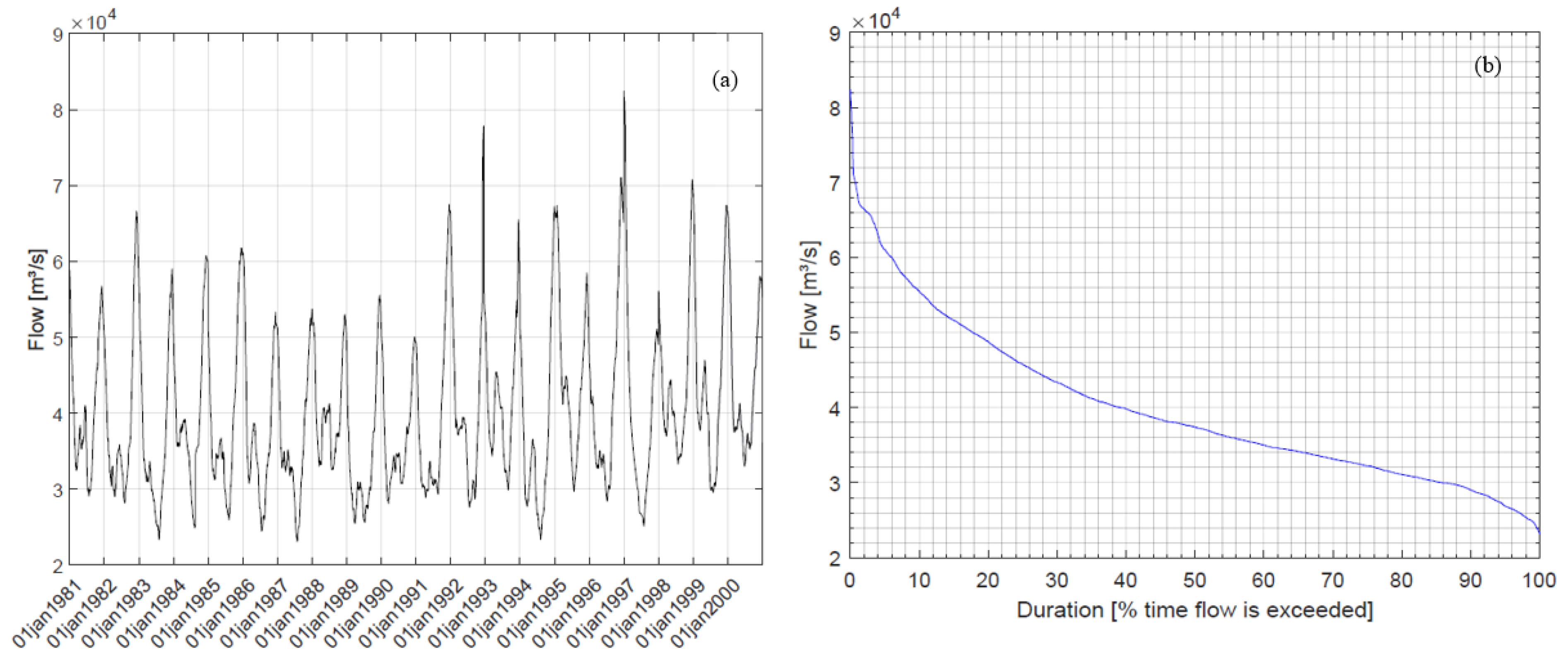
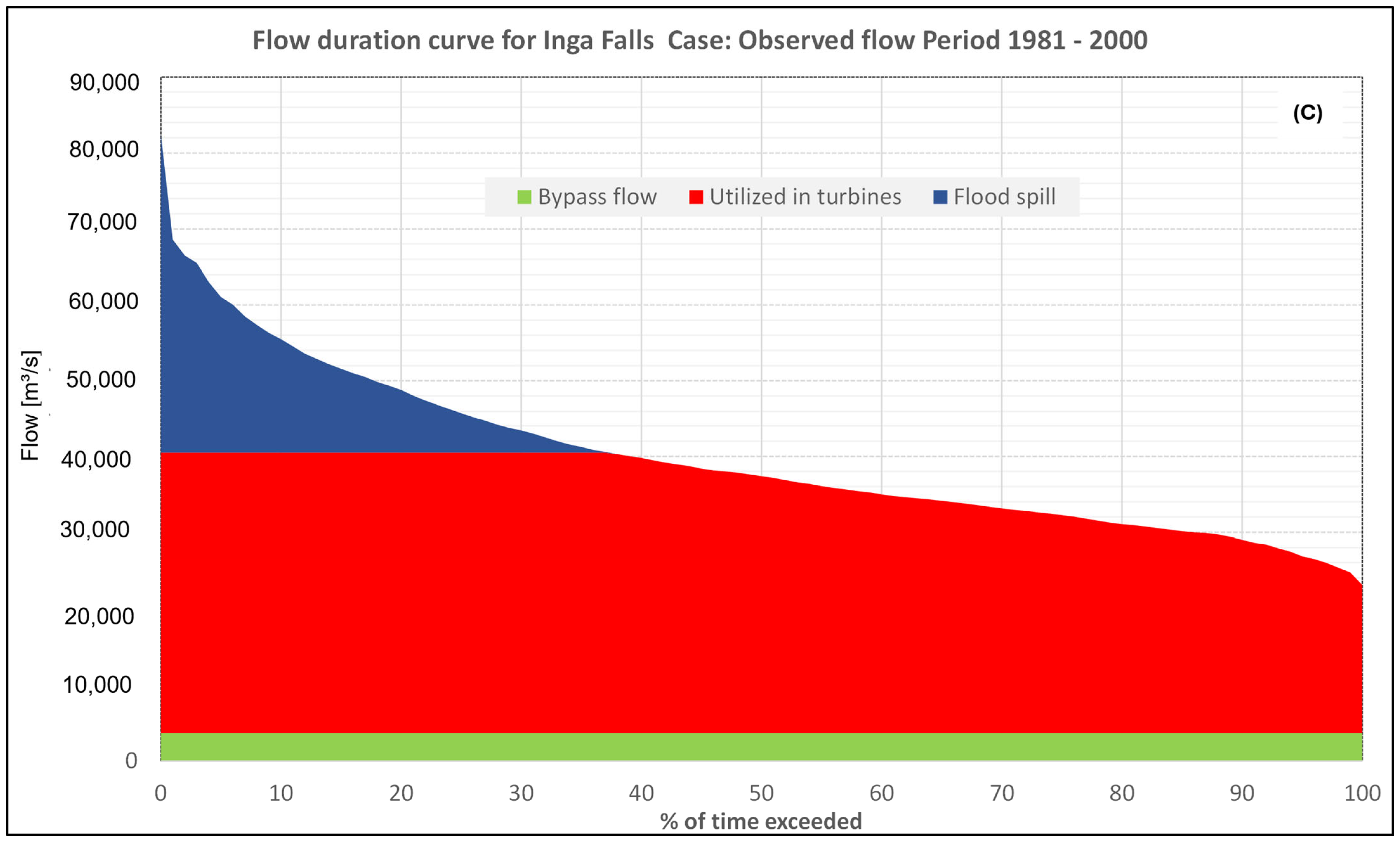

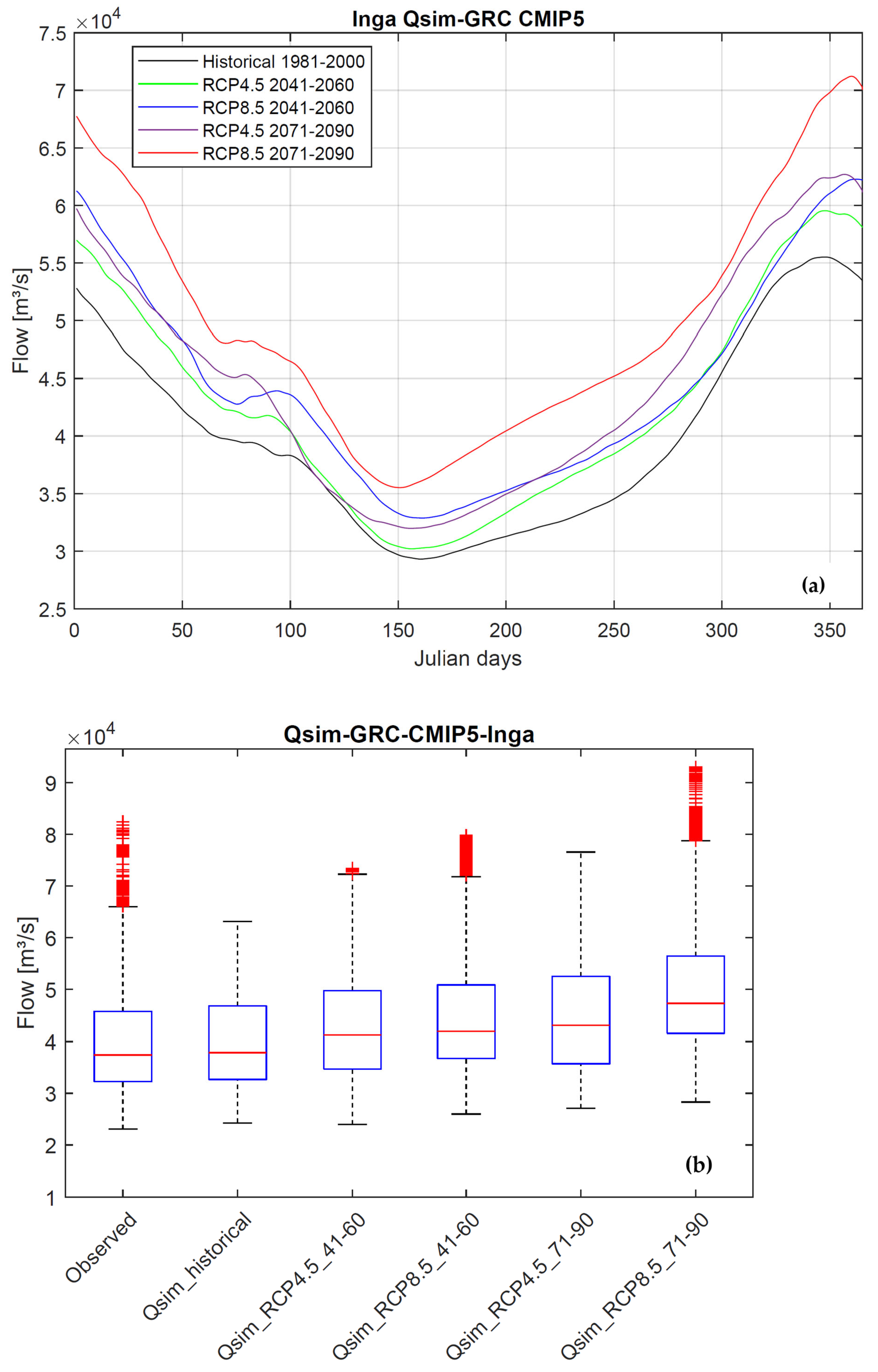
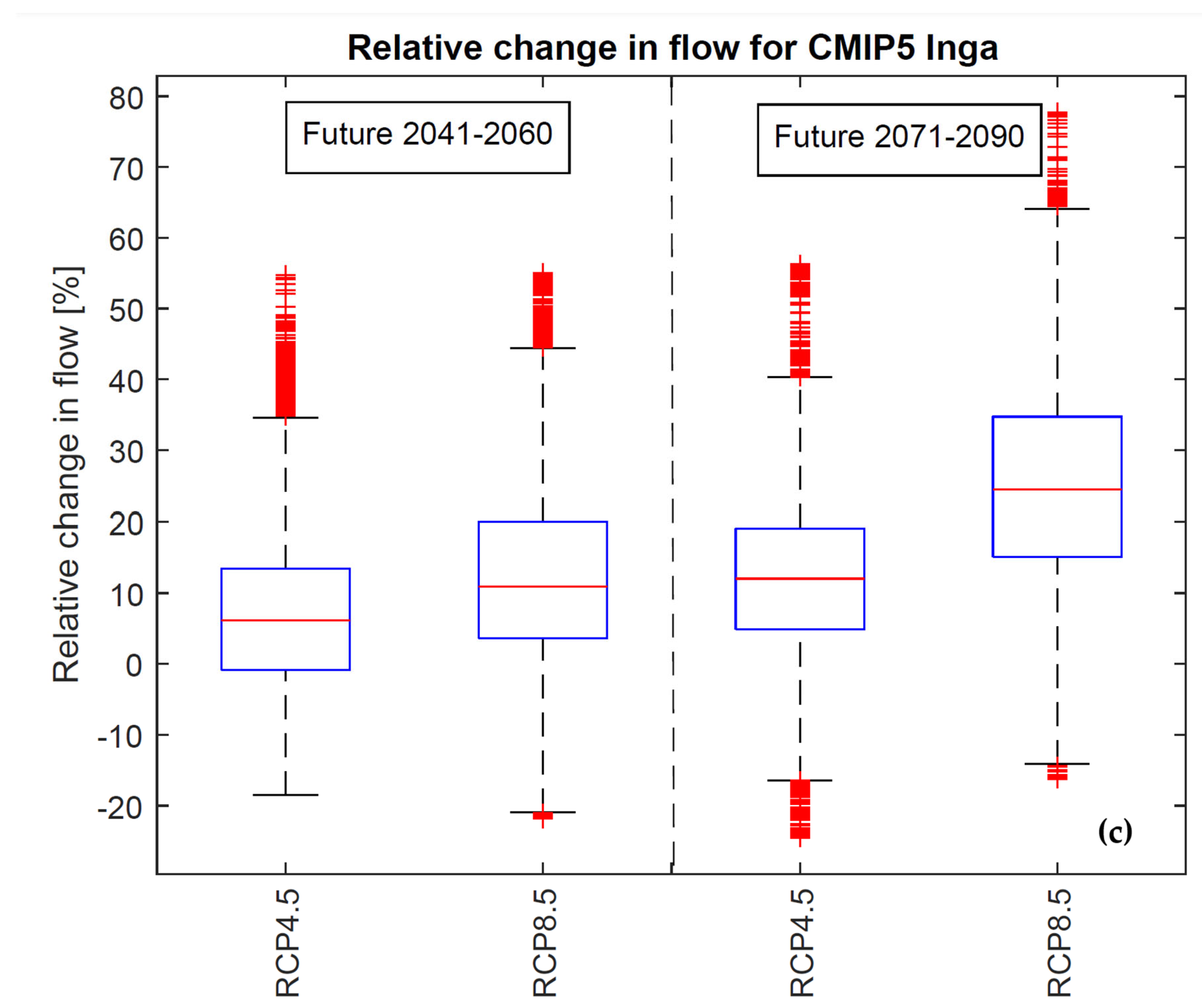
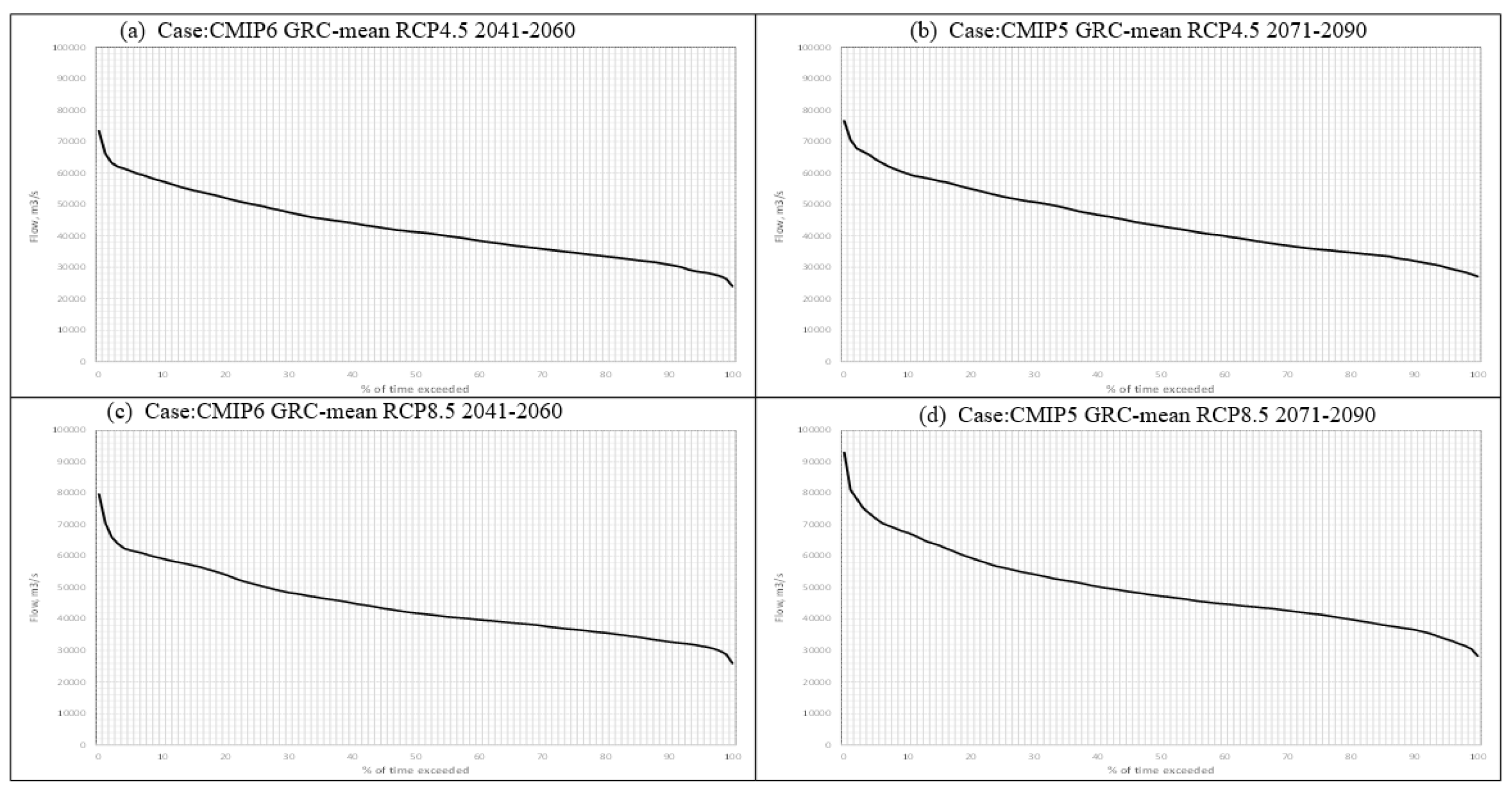
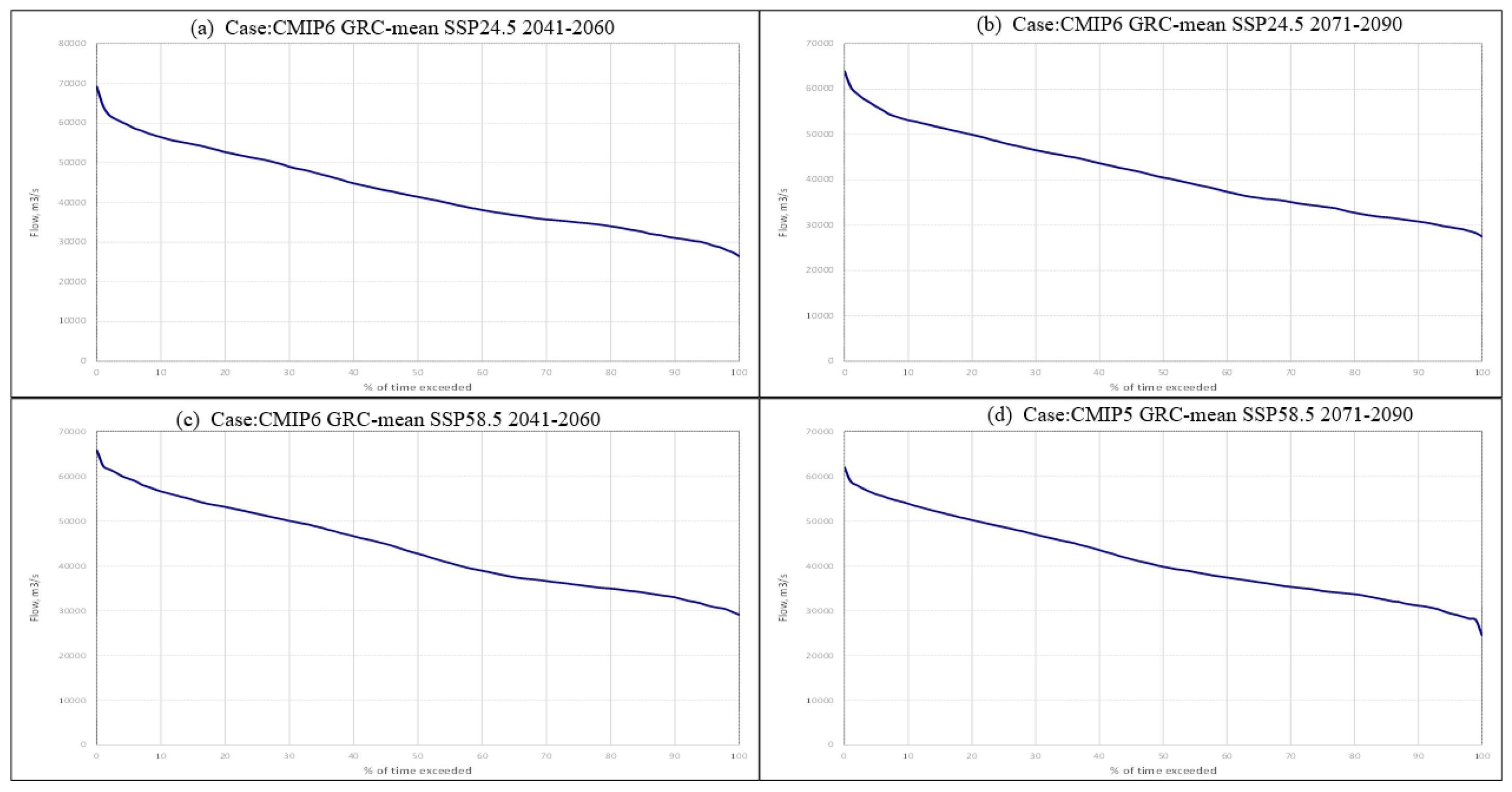
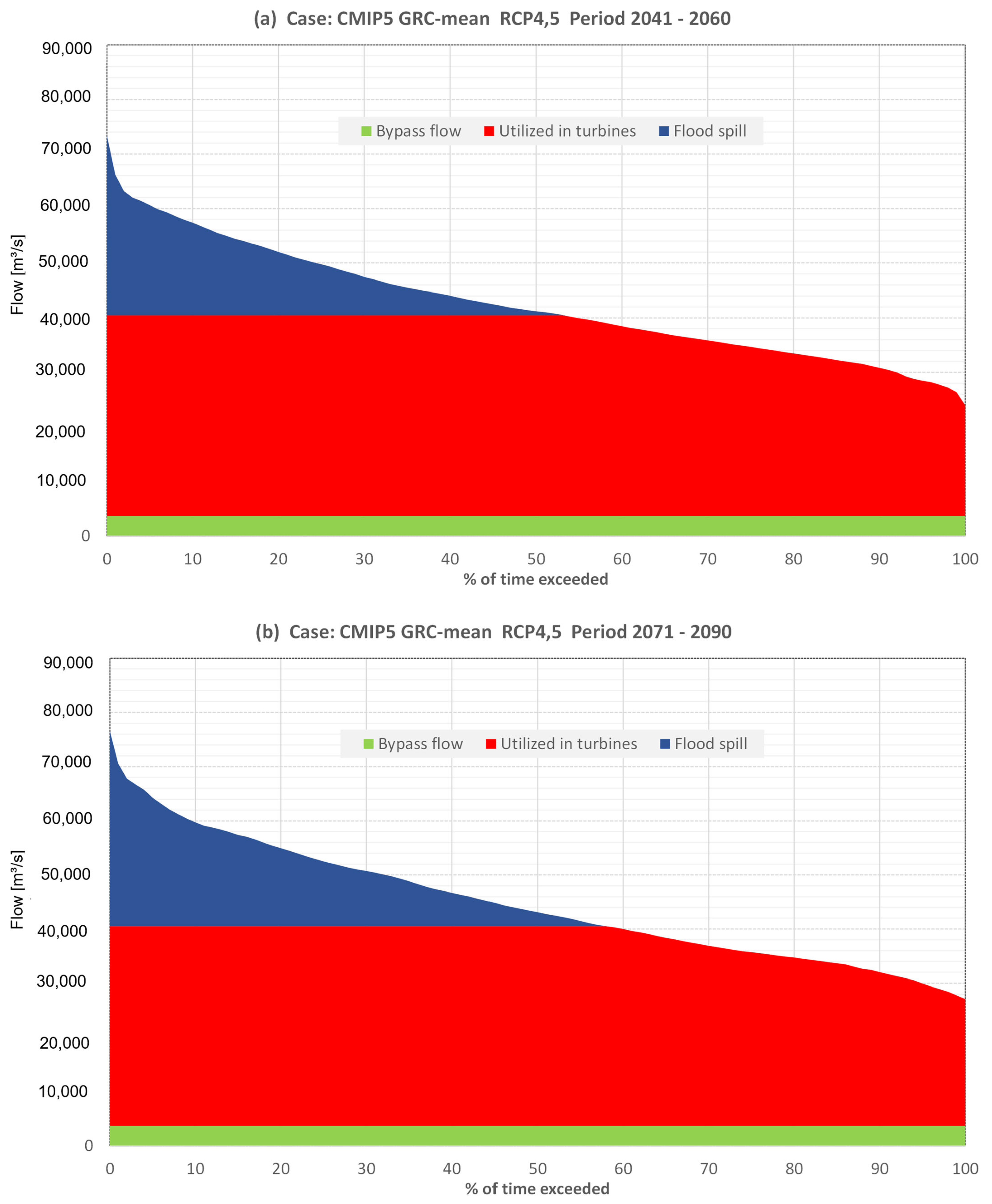
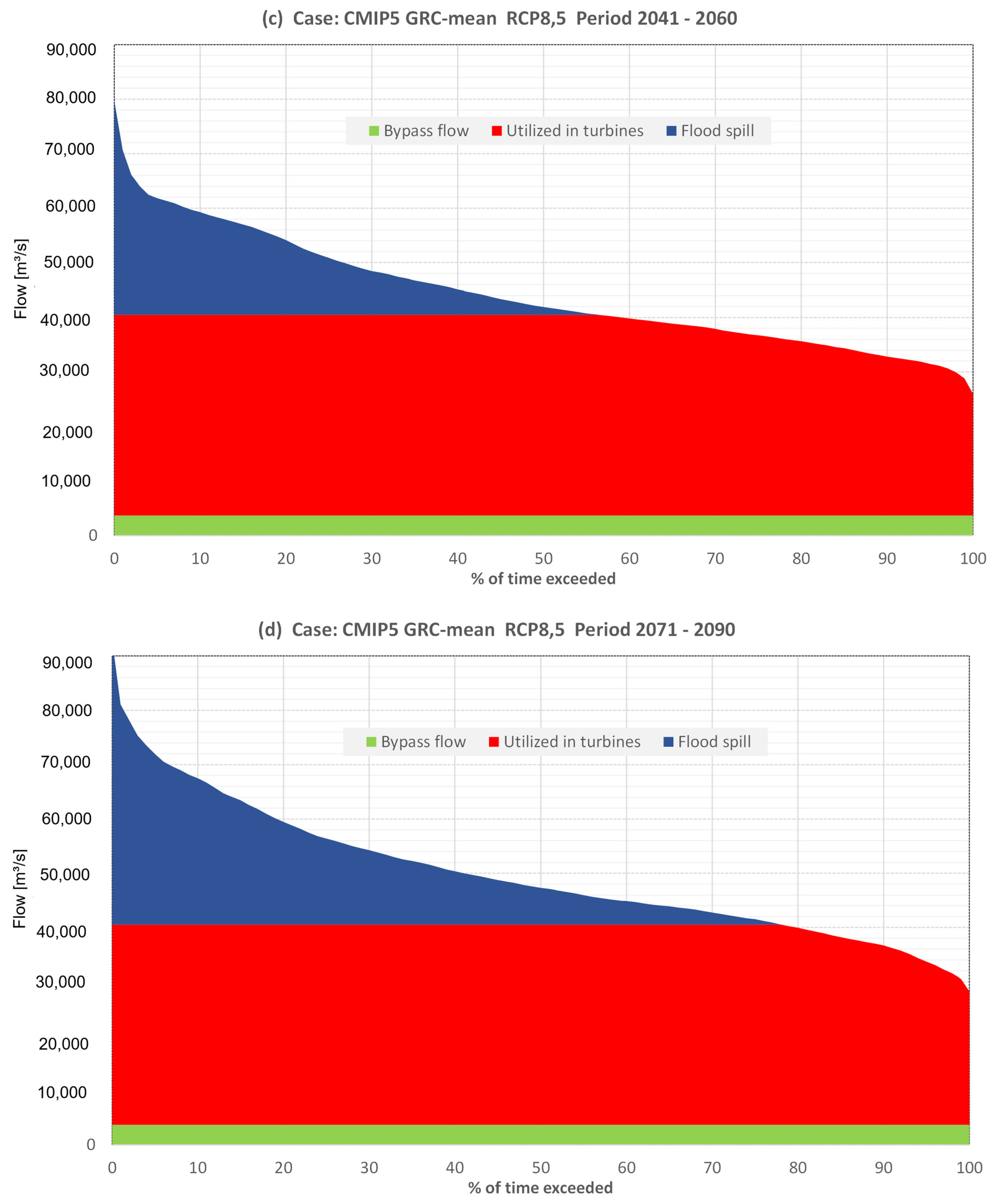
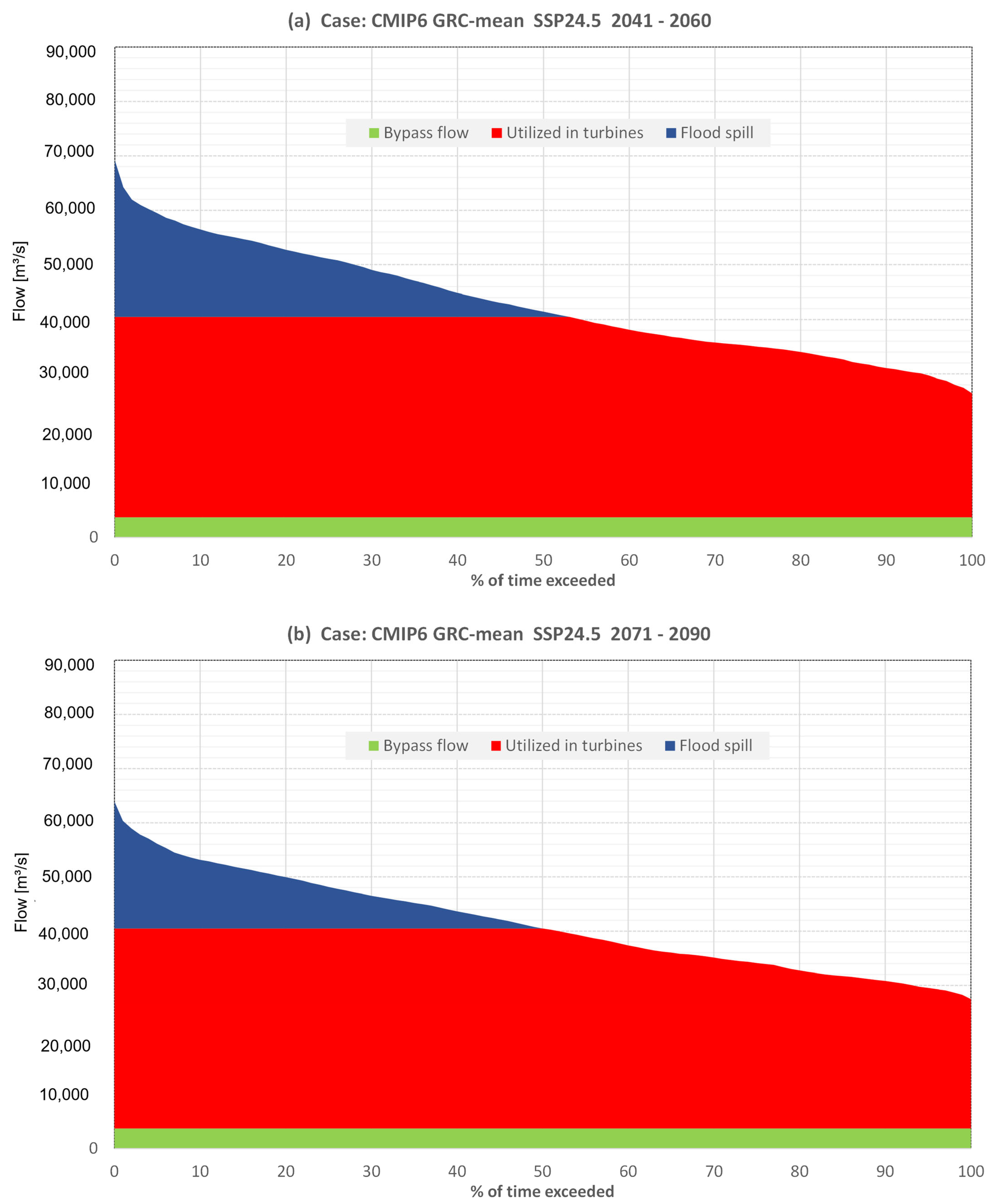

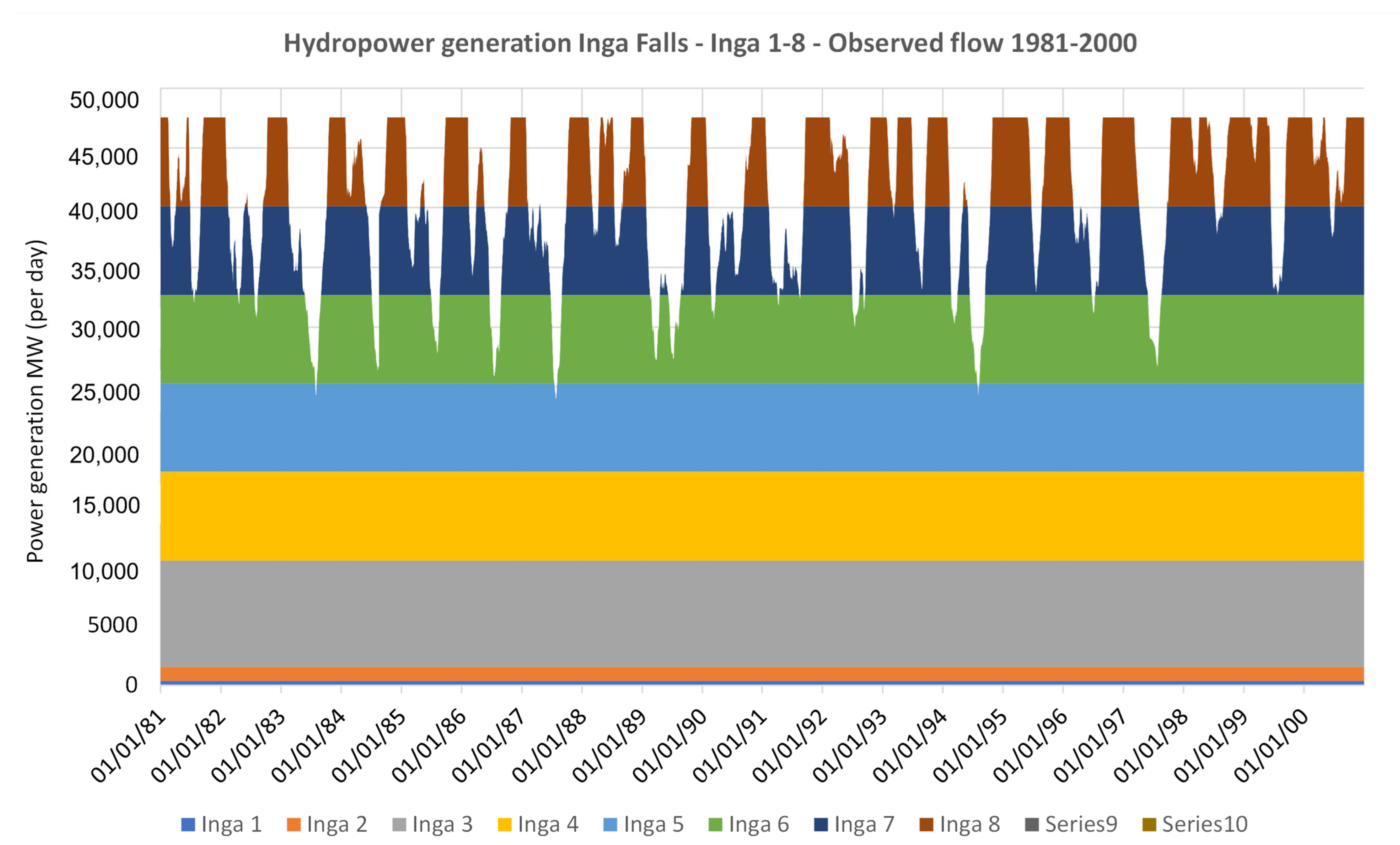
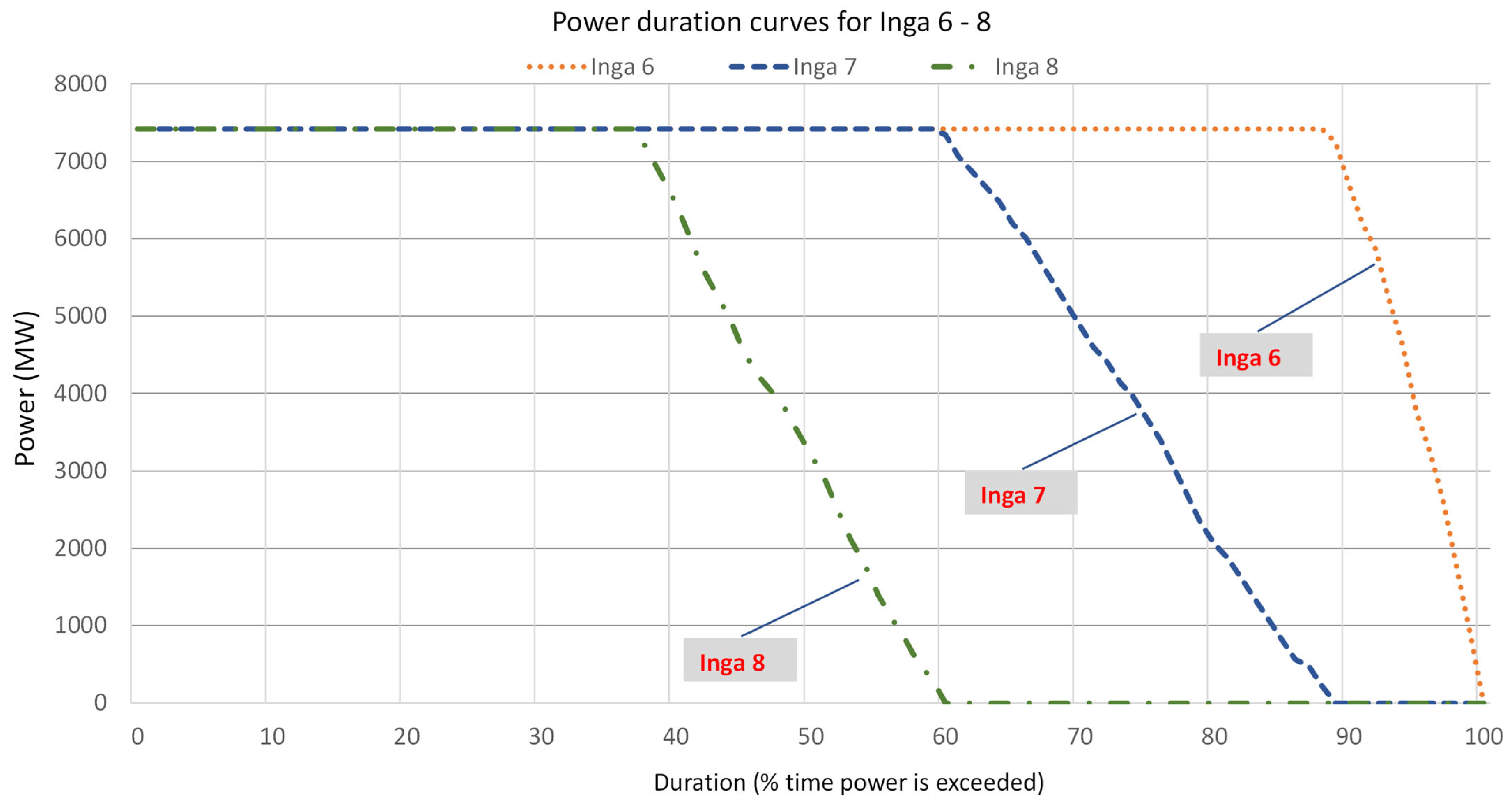
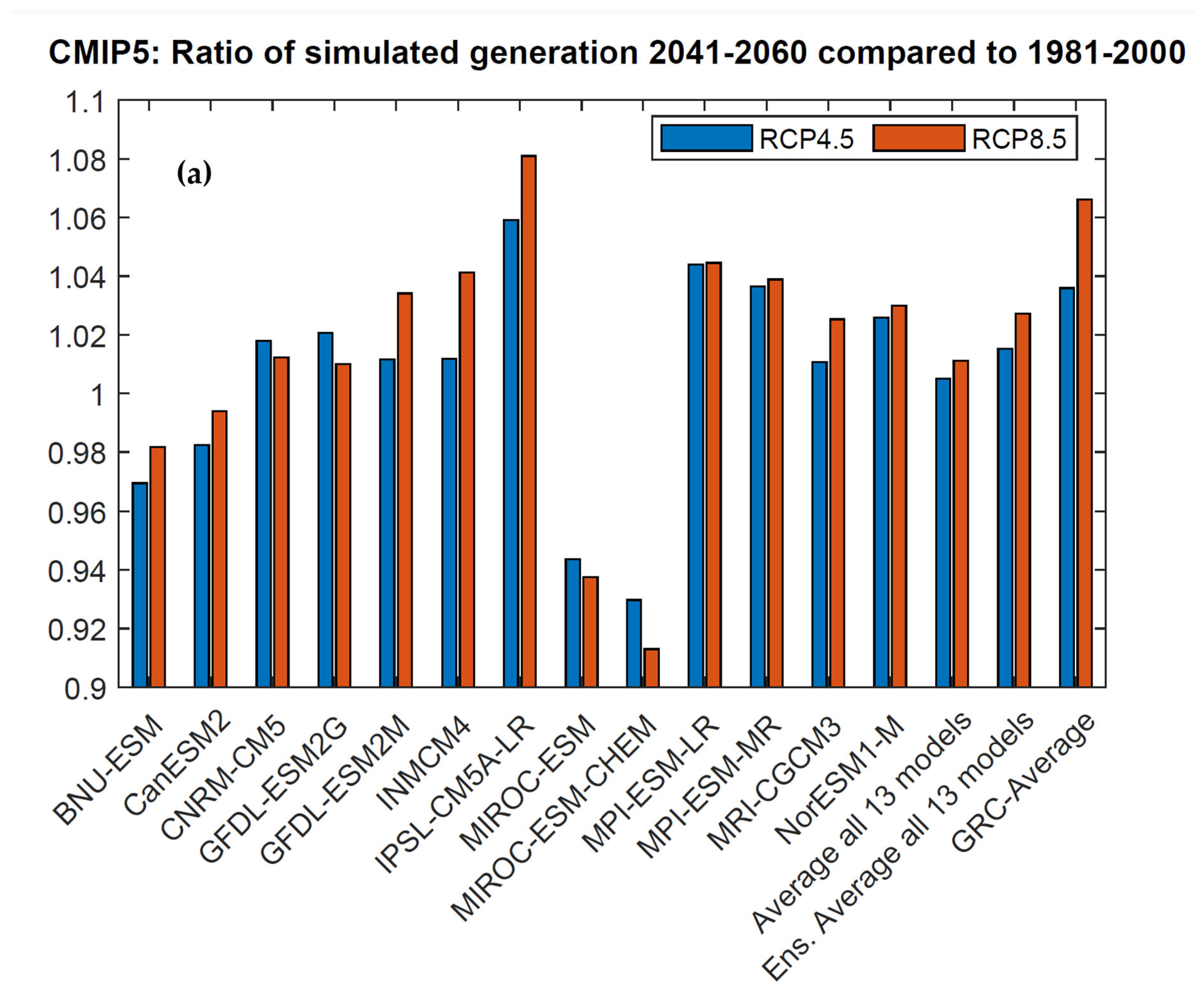
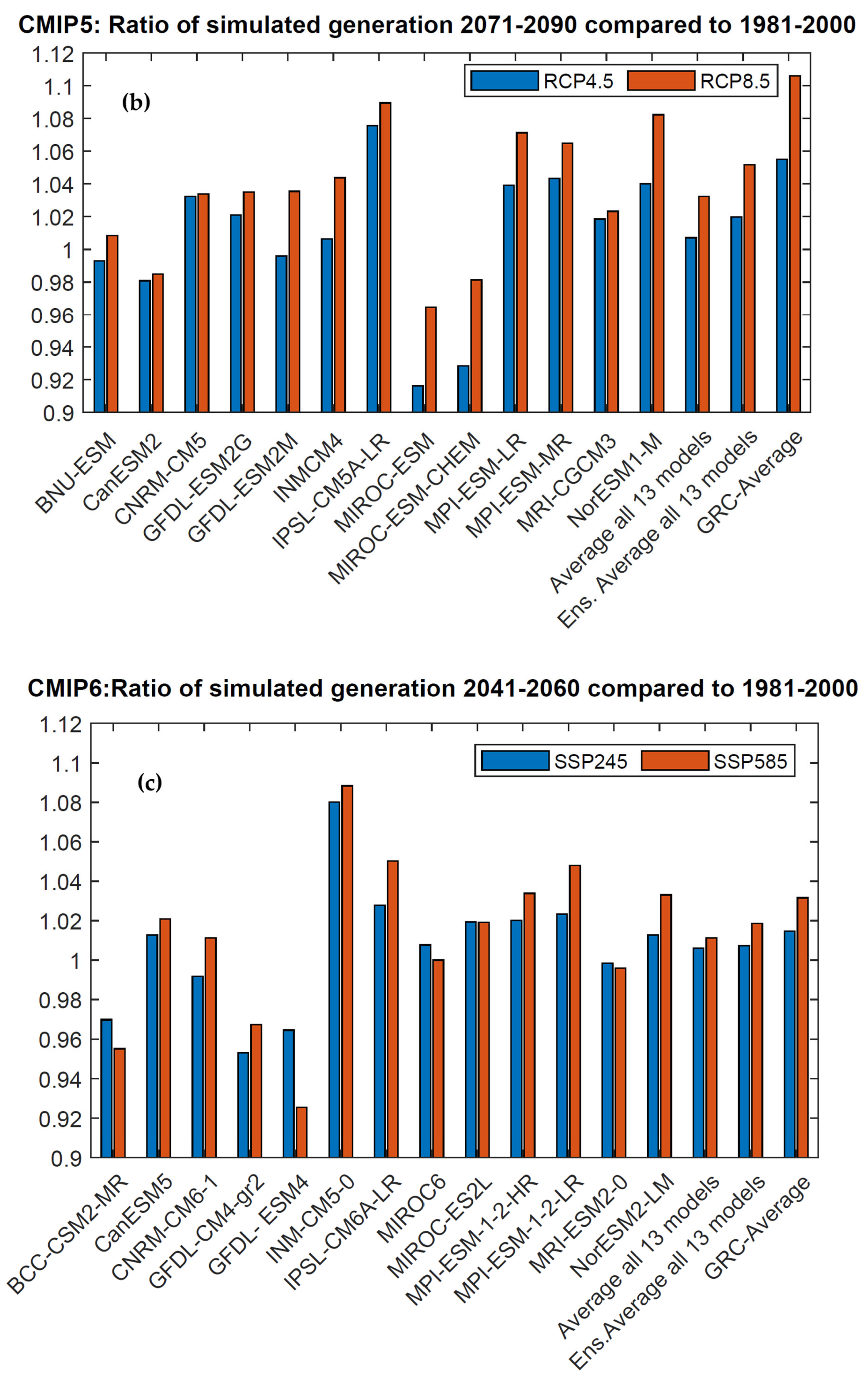
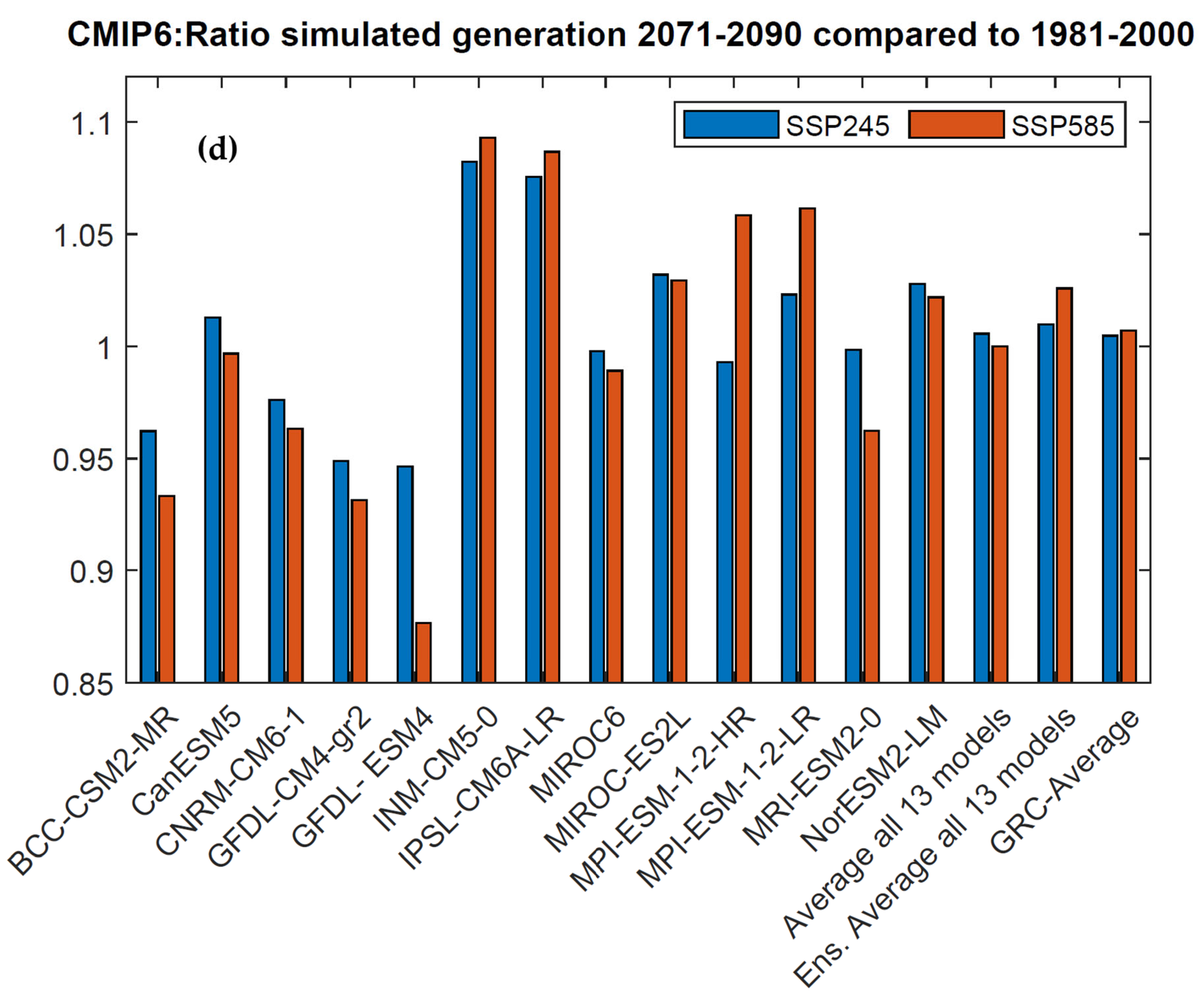
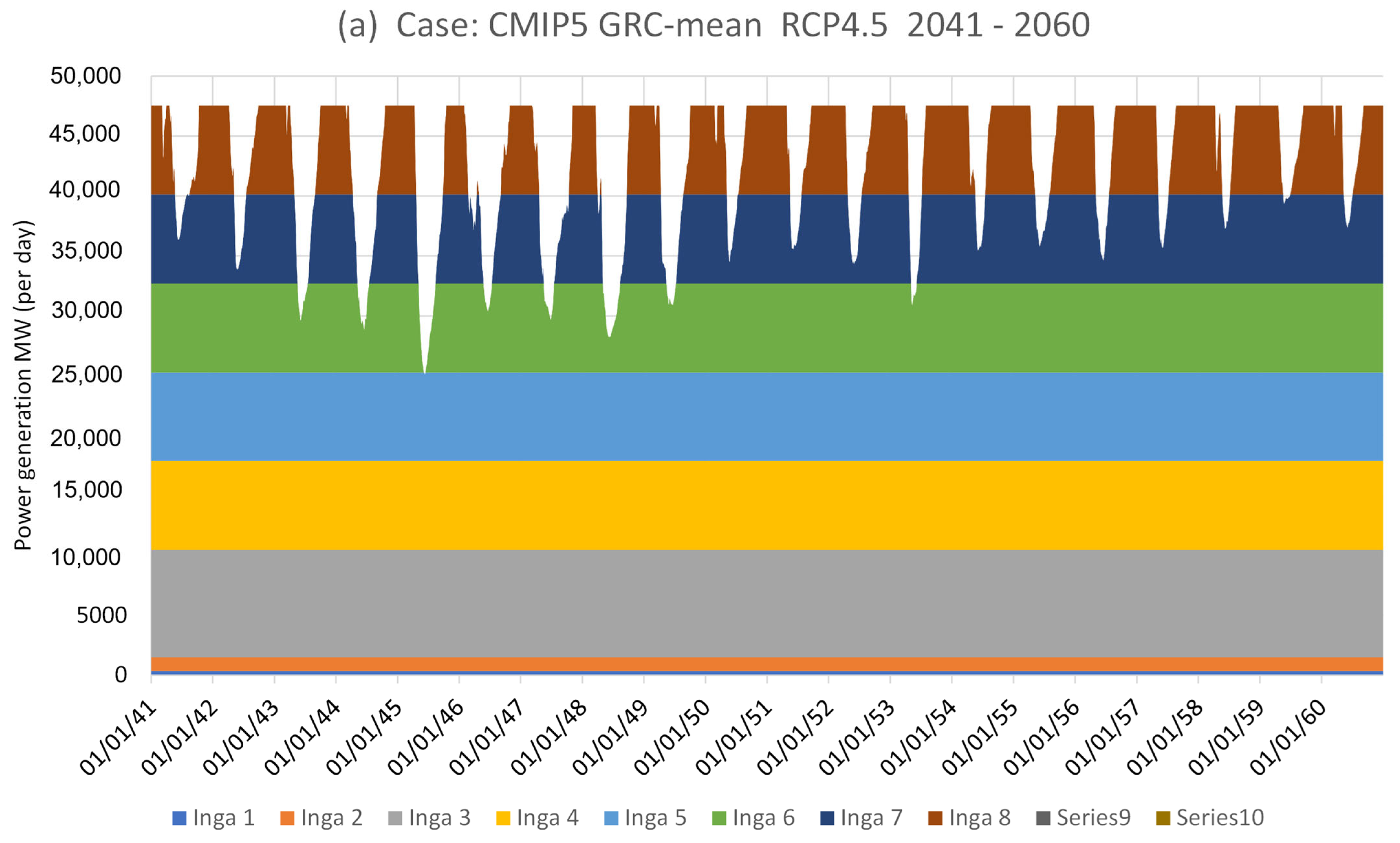
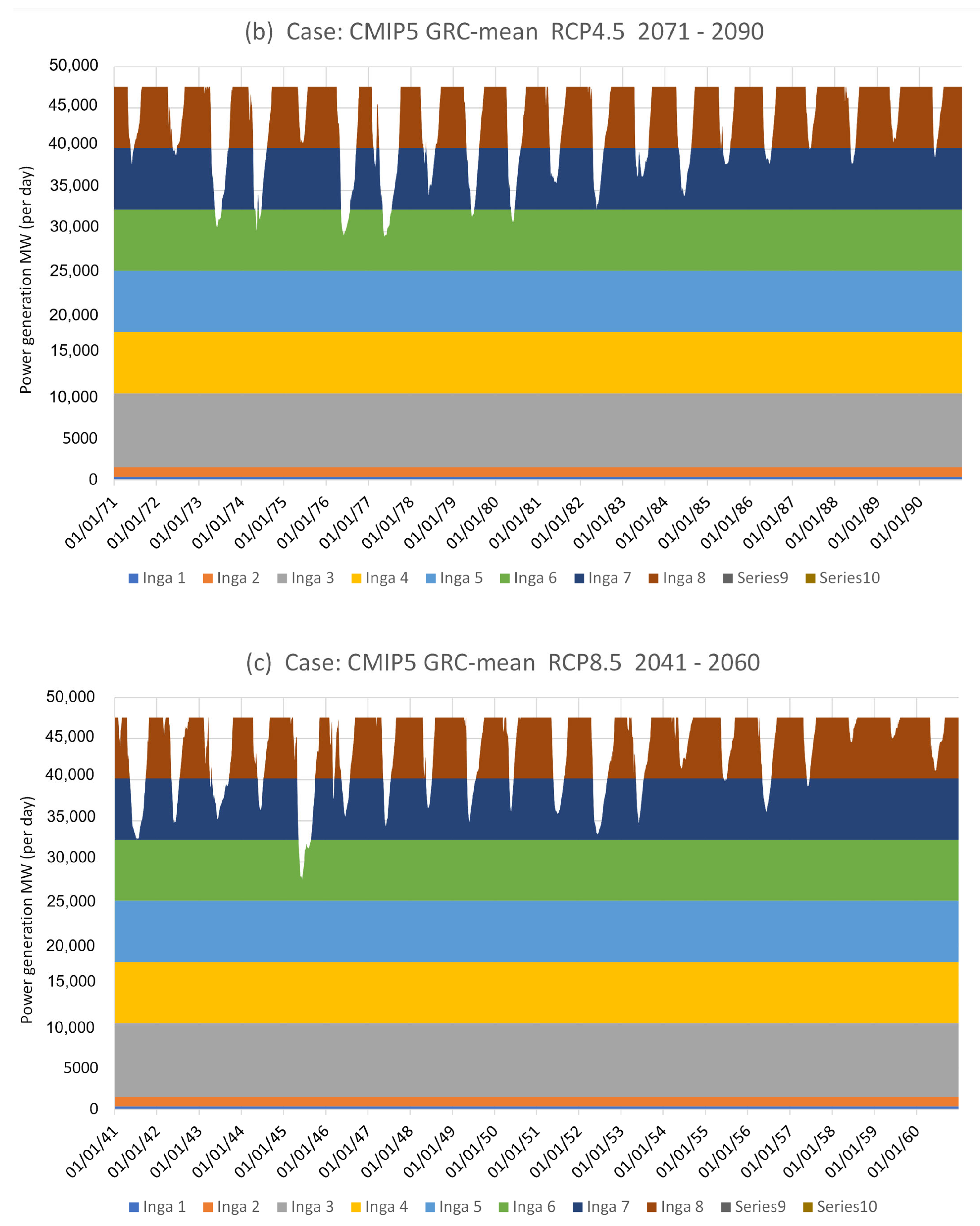
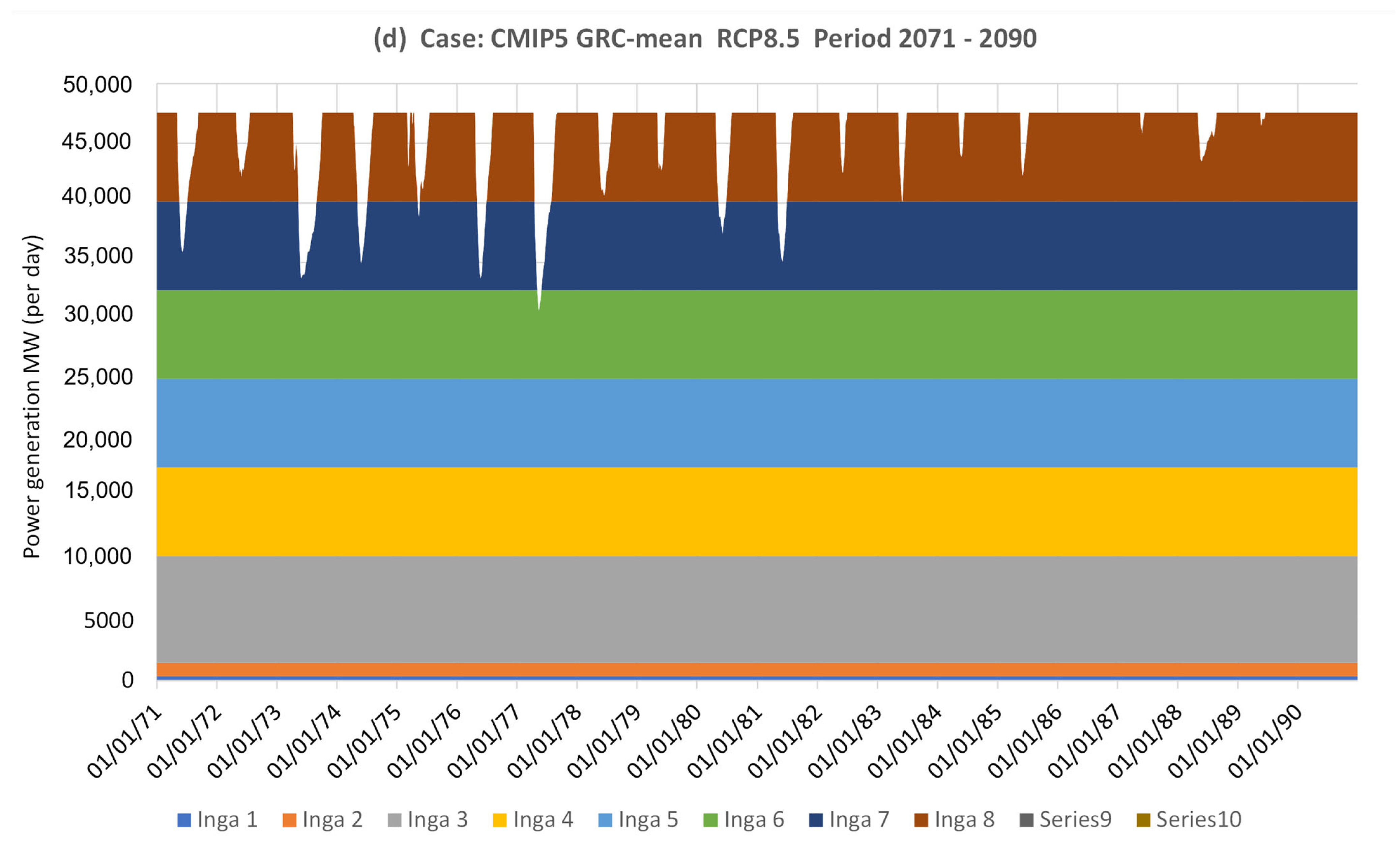
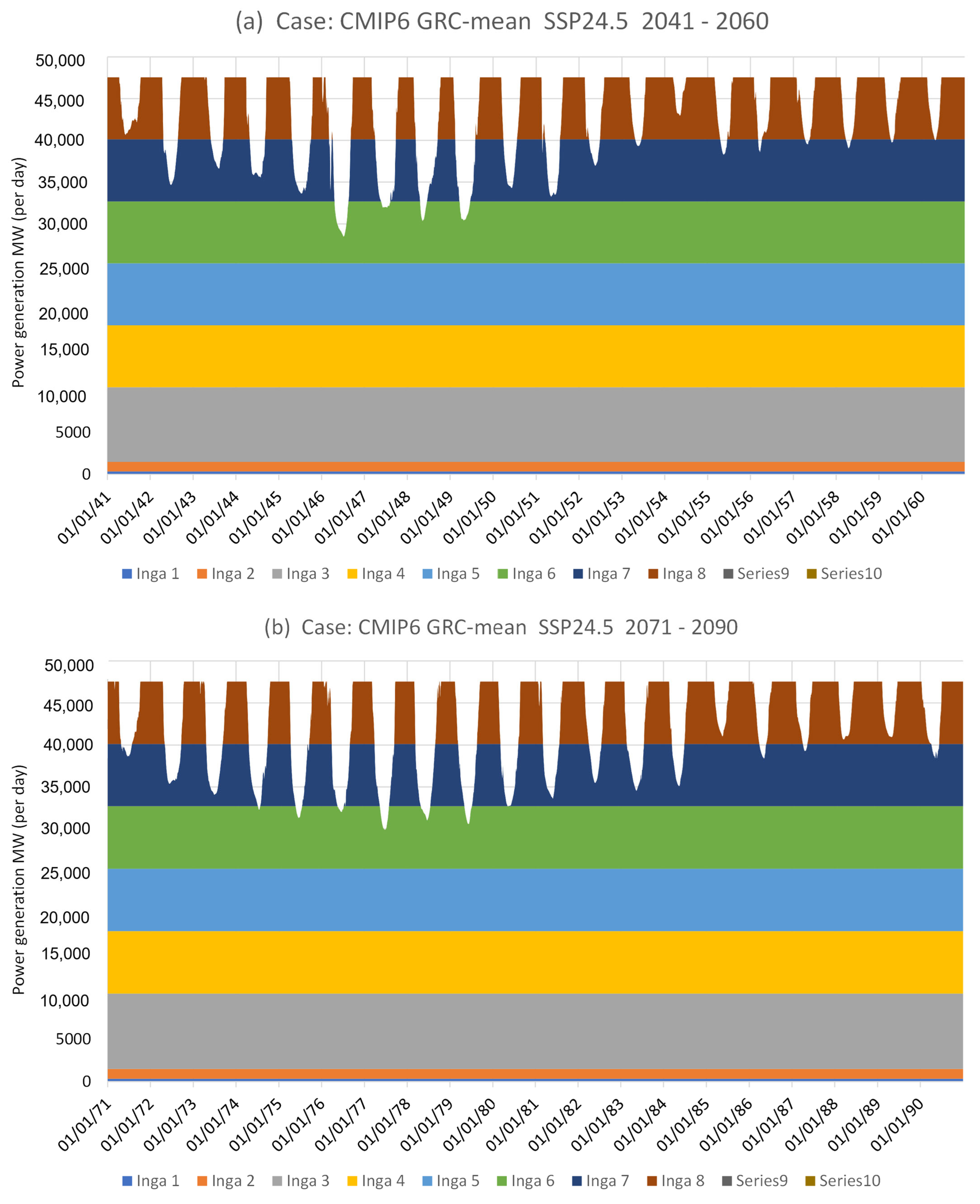
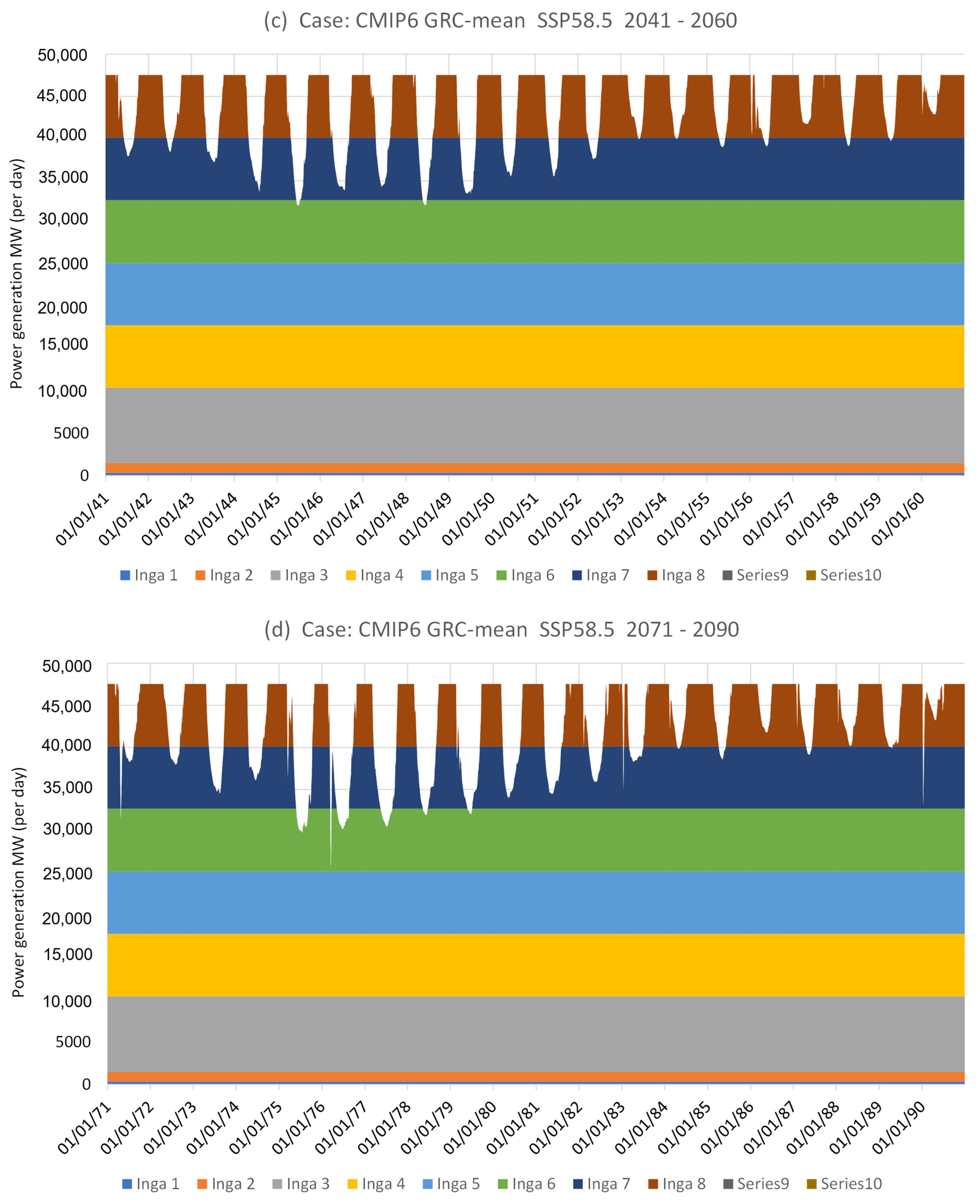
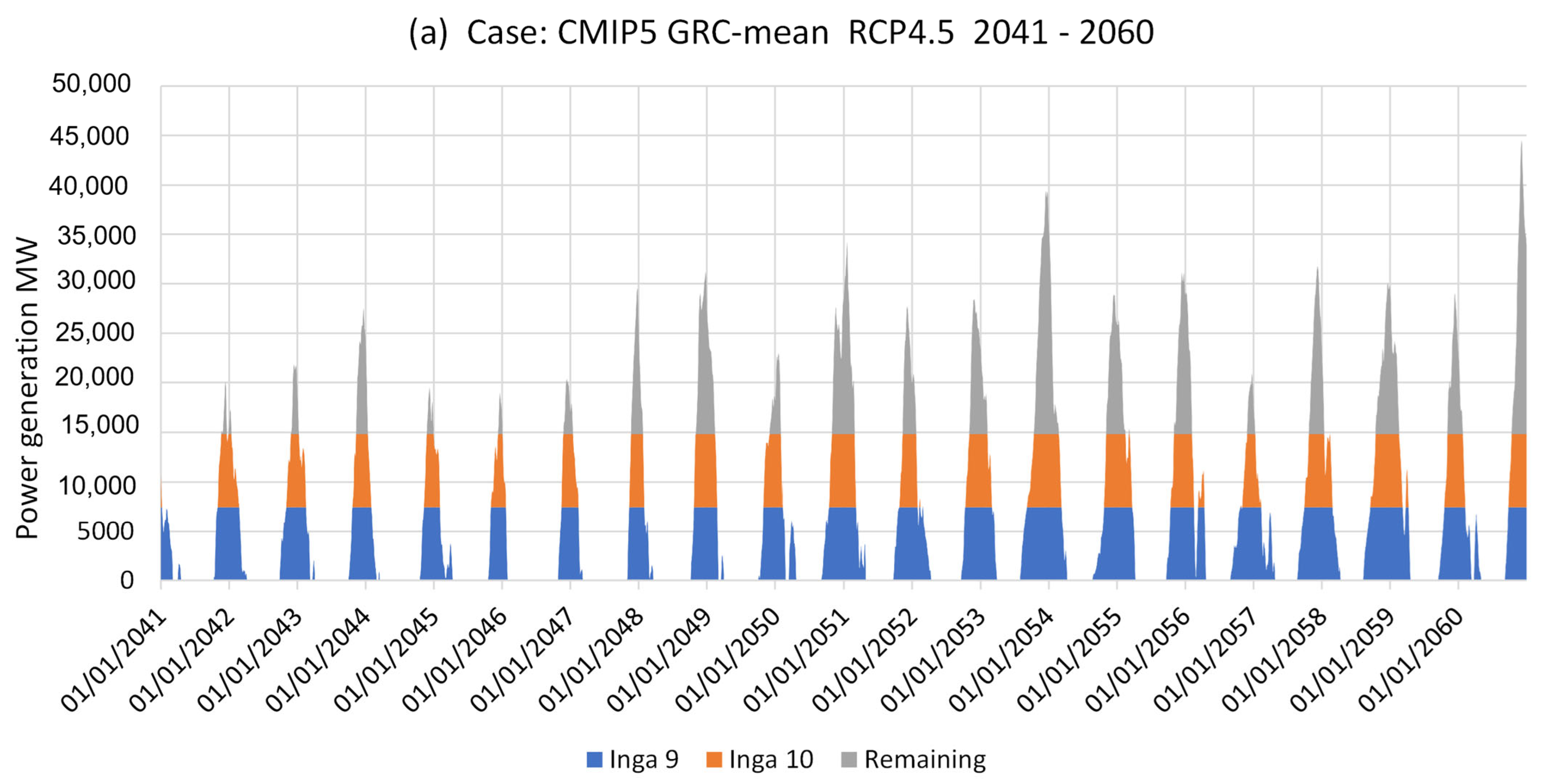
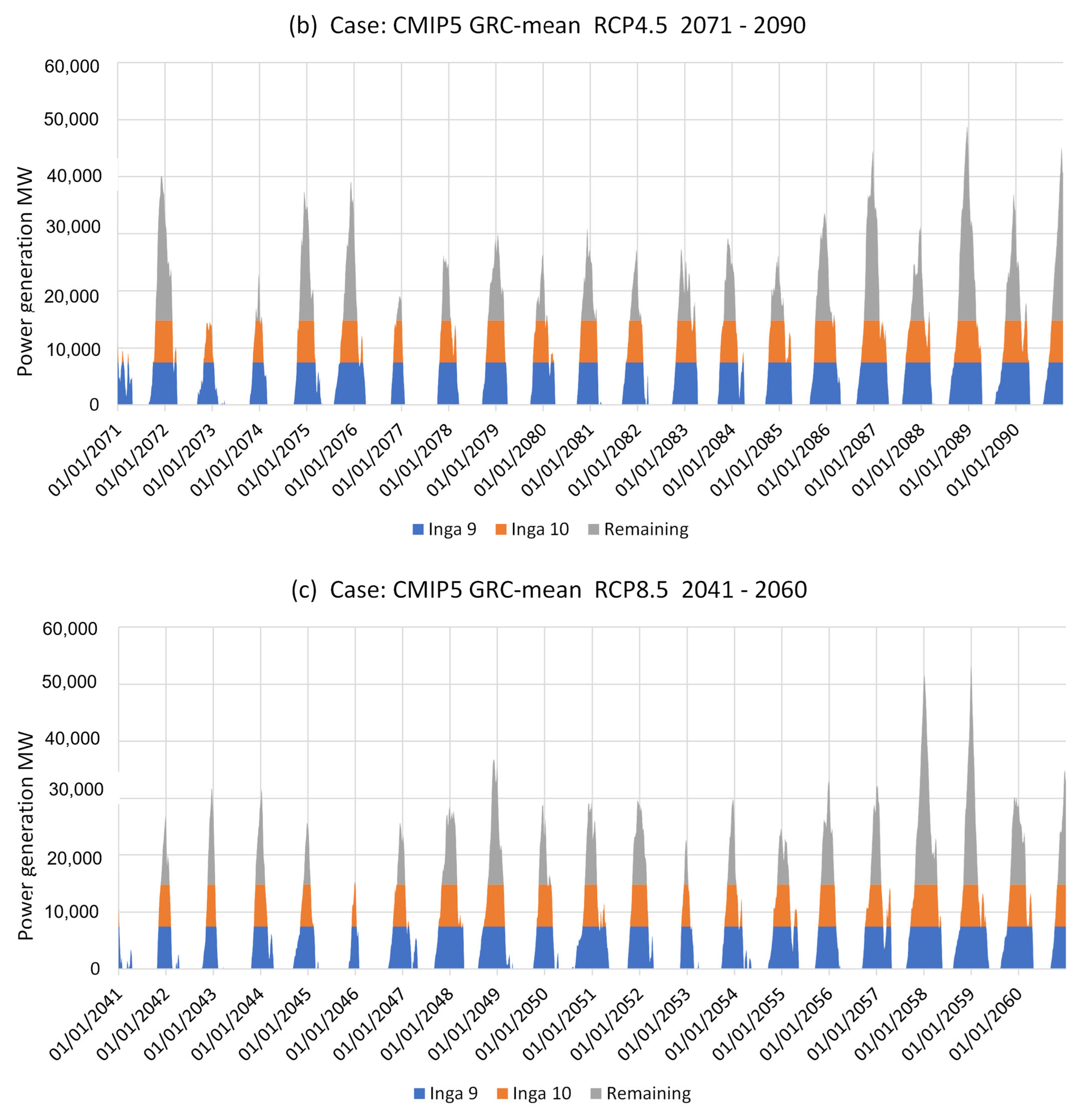

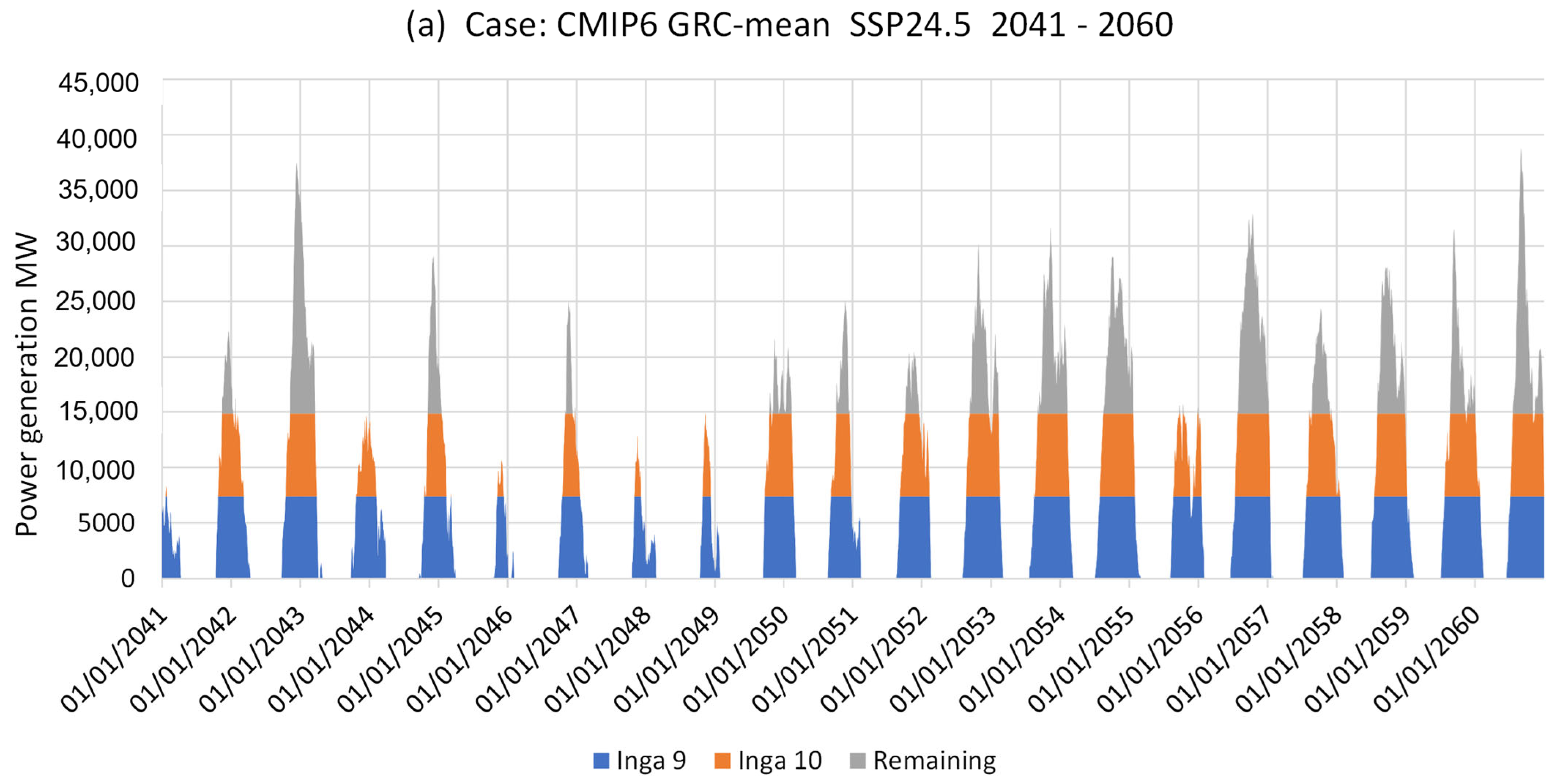

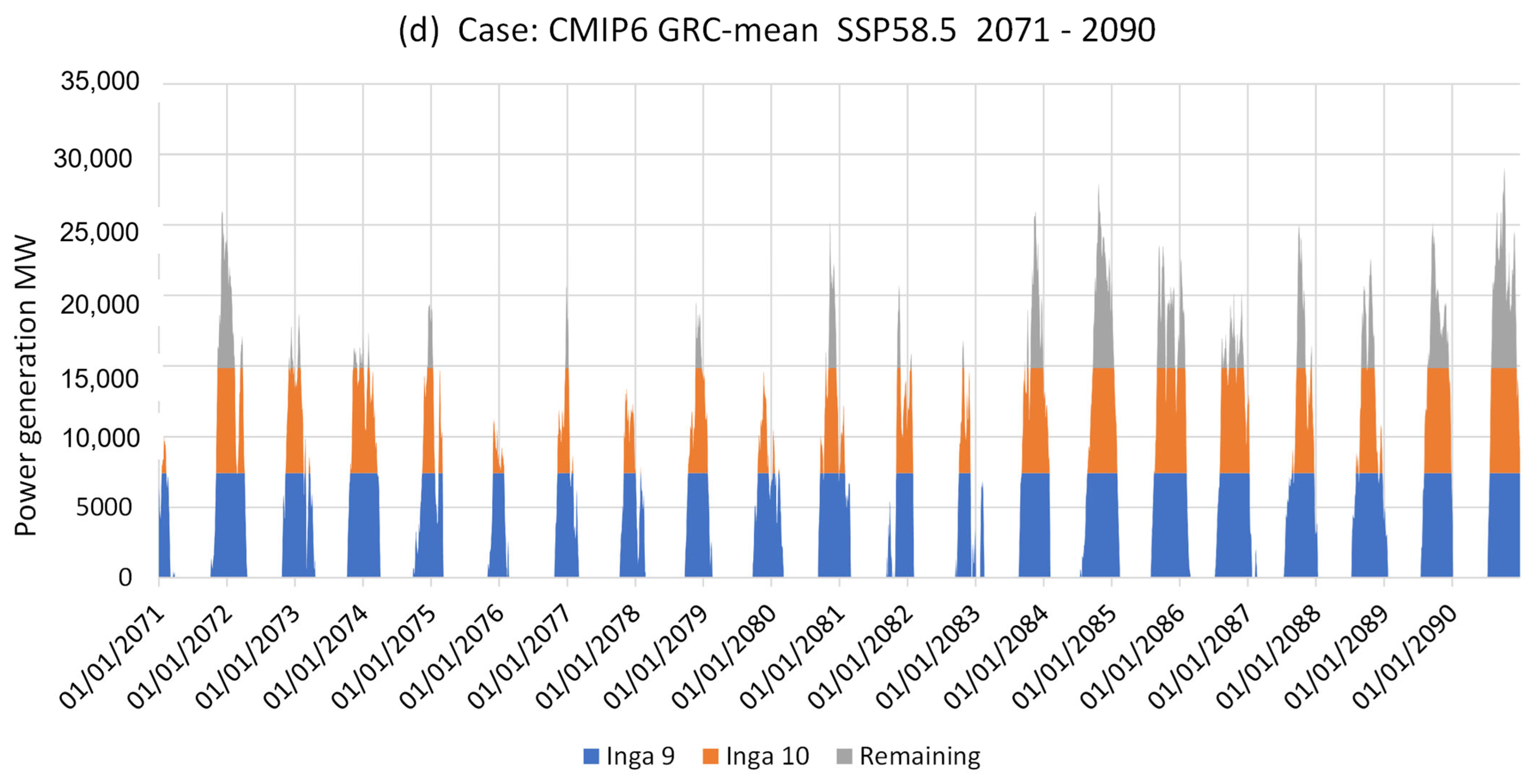
| Main Steps (Phases) in Inga’s Development | Data per Unit (Turbine/Generator) | |||||
|---|---|---|---|---|---|---|
| Phase | # of Units | Qmax [m3/s] | Head [m] | EEQV1 [KWh/m3] | EEQV2 [MW/m3/s] | Pmax [MW] |
| Inga 1 | 6 | 130 | 50 | 0.125 | 0.450 | 58.5 |
| Inga 2 | 8 | 252.5 | 58 | 0.157 | 0.566 | 143 |
| Inga 3 | 11 | 600 | 150 | 0.376 | 1.354 | 813 |
| Inga 4 | 8 | 685 | 150 | 0.376 | 1.354 | 928 |
| Inga 5 | 8 | 685 | 150 | 0.376 | 1.354 | 928 |
| Inga 6 | 8 | 685 | 150 | 0.376 | 1.354 | 928 |
| Inga 7 | 8 | 685 | 150 | 0.376 | 1.354 | 928 |
| Inga 8 | 8 | 685 | 150 | 0.376 | 1.354 | 928 |
| Inga 9 | 8 | 685 | 150 | 0.376 | 1.354 | 928 |
| Inga 10 | 8 | 685 | 150 | 0.376 | 1.354 | 928 |
| Rest | 1 | |||||
| Cumulative Values | ||
|---|---|---|
| Qmax | Pmax | |
| Phase | m3/s | MW |
| Inga 1 | 780 | 351 |
| Inga 2 | 2800 | 1495 |
| Inga 3 | 9400 | 10,434 |
| Inga 4 | 14,880 | 17,856 |
| Inga 5 | 20,360 | 25,278 |
| Inga 6 | 25,840 | 32,700 |
| Inga 7 | 31,320 | 40,122 |
| Inga 8 | 36,800 | 47,544 |
| Model Name | Modeling Agency | Resolution Lon. × Lat. | |
|---|---|---|---|
| CMIP6 | CMIP5 | ||
| BCC-CSM2-MR | BNU-ESM | Beijing Climate Center, China Meteorological Administration (China) | 0.25° × 0.25° |
| CanESM5 | CanESM2 | Canadian Centre for Climate Modelling and Analysis (Canada) | 0.25° × 0.25° |
| CNRM-CM6-1 | CNRM-CM5 | Centre National de Recherches Météorologiques, France | 0.25° × 0.25° |
| GFDL-CM4-gr2 | GFDL-ESM2G | Geophysical Fluid Dynamics Laboratory, USA | 0.25° × 0.25° |
| GFDL-ESM4 | GFDL-ESM2M | Geophysical Fluid Dynamics Laboratory, USA | 0.25° × 0.25° |
| INM-CM5-0 | INM-CM4 | Institute for Numerical Mathematics, Russian Academy of Science/Russia | 0.25° × 0.25° |
| IPSL-CM6A-LR | IPSL-CM5A-LR | L’Institut Pierre-Simon Laplace (France) | 0.25° × 0.25° |
| MIROC6 | MIROC-ESM | National Institute for Environmental Studies, The University of Tokyo (Japan) | 0.25° × 0.25° |
| MIROC-ES2L | MIROC-ESM-CHEM | National Institute for Environmental Studies, The University of Tokyo (Japan) | 0.25° × 0.25° |
| MPI-ESM-1-2-HR | MPI-ESM-MR | Max Planck Institute for Meteorology (Germany) | 0.25° × 0.25° |
| MPI-ESM-1-2-LR | MPI-ESM-LR | Max Planck Institute for Meteorology (Germany) | 0.25° × 0.25° |
| MRI-ESM2-0 | MRI-CGCM3 | Meteorological Research Institute (Japan) | 0.25° × 0.25° |
| NorESM2-LM | NorESM1-M | Norwegian Climate Centre (Norway) | 0.25° × 0.25° |
| Cumulative Values | Results for 1981–2000 | ||||
|---|---|---|---|---|---|
| Qmax | Pmax | Energy | FLH | Cf | |
| Phase | m3/s | MW | TWh/yr | hours | % |
| Inga 1 | 780 | 351 | 2.4 | 8760 | 100 |
| Inga 2 | 2800 | 1495 | 10.4 | 8760 | 100 |
| Inga 3 | 9400 | 10,434 | 88.7 | 8760 | 100 |
| Inga 4 | 14,880 | 17,856 | 153.7 | 8760 | 100 |
| Inga 5 | 20,360 | 25,278 | 218.7 | 8756 | 100 |
| Inga 6 | 25,840 | 32,700 | 280.5 | 8320 | 95 |
| Inga 7 | 31,320 | 40,122 | 328.8 | 6510 | 74 |
| Inga 8 | 36,800 | 47,544 | 360.1 | 4221 | 48 |
| Simulated hydropower generation (TWh/year) for power plant units included in Inga Phase 3 to Phase 8 | Average | Average | Average | |||||||||||||||||
| IPCC Asessment | Emission Scenario | Time period | BNU-ESM | CanESM2 | CNRM-CM5 | GFDL-ESM2G | GFDL-ESM2M | inmcm4 | IPSL-CM5A-LR | MIROC-ESM | MIROC-ESM-CHEM | MPI-ESM-LR | MPI-ESM-MR | MRI-CGCM3 | NorESM1-M | Average all 13 models | Ensamble Average all 13 models | GRC-Average | ||
| Simulated annual generation, CMIP5 | CMIP5 | - | 1981–2000 | 363.8 | 370.8 | 367.7 | 365.2 | 367.9 | 358.7 | 368.0 | 366.8 | 361.9 | 369.7 | 371.6 | 372.3 | 365.9 | 366.9 | 371.5 | 355.0 | |
| CMIP5 | RCP4.5 | 2041–2060 | 352.6 | 364.3 | 374.3 | 372.7 | 372.2 | 362.9 | 389.7 | 346.1 | 336.5 | 385.9 | 385.2 | 376.3 | 375.3 | 368.8 | 377.2 | 367.8 | ||
| CMIP5 | RCP4.5 | 2071–2090 | 361.2 | 363.7 | 379.6 | 372.9 | 366.4 | 360.9 | 395.8 | 336.0 | 335.9 | 384.2 | 387.7 | 379.2 | 380.6 | 369.5 | 378.9 | 374.6 | ||
| CMIP5 | RCP8.5 | 2041–2060 | 357.1 | 368.5 | 372.2 | 368.8 | 380.5 | 373.4 | 397.8 | 343.9 | 330.4 | 386.1 | 386.0 | 381.7 | 376.8 | 371.0 | 381.6 | 378.5 | ||
| CMIP5 | RCP8.5 | 2071–2090 | 366.8 | 365.2 | 380.2 | 378.0 | 380.9 | 374.4 | 400.9 | 353.9 | 355.1 | 396.0 | 395.6 | 381.0 | 396.0 | 378.8 | 390.8 | 392.7 | ||
| Simulated hydropower generation (TWh/year) for power plant units included in Inga Phase 3 to Phase 8 | Average | Average | Average | |||||||||||||||||
| IPCC Asessment | Emission Scenario | Time period | BNU-ESM | CanESM2 | CNRM-CM5 | GFDL-ESM2G | GFDL-ESM2M | inmcm4 | IPSL-CM5A-LR | MIROC-ESM | MIROC-ESM-CHEM | MPI-ESM-LR | MPI-ESM-MR | MRI-CGCM3 | NorESM1-M | Average all 13 models | Ensamble Average all 13 models | GRC-Average | ||
| Simulated annual generation, CMIP6 | CMIP6 | - | 1981–2000 | 369.8 | 374.7 | 379.6 | 378.9 | 378.7 | 369.3 | 369.9 | 374.2 | 373.0 | 376.0 | 376.5 | 379.5 | 371.4 | 374.7 | 377.5 | 363.8 | |
| CMIP6 | SSP24.5 | 2041–2060 | 358.6 | 379.5 | 376.5 | 361.0 | 365.2 | 398.9 | 380.2 | 377.1 | 380.2 | 383.6 | 385.4 | 378.9 | 376.1 | 377.0 | 380.2 | 369.1 | ||
| CMIP6 | SSP24.5 | 2071–2090 | 355.8 | 379.5 | 370.6 | 359.5 | 358.4 | 399.7 | 397.9 | 373.4 | 384.9 | 373.4 | 385.2 | 378.9 | 381.7 | 376.8 | 381.2 | 365.5 | ||
| CMIP6 | SSP58.5 | 2041–2060 | 353.2 | 382.5 | 383.9 | 366.5 | 350.4 | 402.0 | 388.5 | 374.2 | 380.2 | 388.7 | 394.6 | 378.0 | 383.7 | 378.9 | 384.5 | 375.3 | ||
| CMIP6 | SSP58.5 | 2071–2090 | 345.0 | 373.5 | 365.7 | 352.8 | 331.9 | 403.6 | 402.0 | 370.2 | 383.9 | 398.0 | 399.7 | 365.3 | 379.5 | 374.7 | 387.2 | 366.4 | ||
| IPCC Asessment | Emission Scenario | Time period | BNU-ESM | CanESM2 | CNRM-CM5 | GFDL-ESM2G | GFDL-ESM2M | inmcm4 | IPSL-CM5A-LR | MIROC-ESM | MIROC-ESM-CHEM | MPI-ESM-LR | MPI-ESM-MR | MRI-CGCM3 | NorESM1-M | Average all 13 models | Ensamble Average all 13 models | GRC-Average | ||
| Relative change - CMIP5 | CMIP5 | RCP4.5 | 2041–2060 | 0.97 | 0.98 | 1.02 | 1.02 | 1.01 | 1.01 | 1.06 | 0.94 | 0.93 | 1.04 | 1.04 | 1.01 | 1.03 | 1.00 | 1.02 | 1.04 | |
| CMIP5 | RCP4.5 | 2071–2090 | 0.99 | 0.98 | 1.03 | 1.02 | 1.00 | 1.01 | 1.08 | 0.92 | 0.93 | 1.04 | 1.04 | 1.02 | 1.04 | 1.01 | 1.02 | 1.05 | ||
| CMIP5 | RCP8.5 | 2041–2060 | 0.98 | 0.99 | 1.01 | 1.01 | 1.03 | 1.04 | 1.08 | 0.94 | 0.91 | 1.04 | 1.04 | 1.03 | 1.03 | 1.01 | 1.03 | 1.07 | ||
| CMIP5 | RCP8.5 | 2071–2090 | 1.01 | 0.98 | 1.03 | 1.03 | 1.04 | 1.04 | 1.09 | 0.96 | 0.98 | 1.07 | 1.06 | 1.02 | 1.08 | 1.03 | 1.05 | 1.11 | ||
| Relative change - CMIP6 | CMIP6 | SSP24.5 | 2041–2060 | 0.97 | 1.01 | 0.99 | 0.95 | 0.96 | 1.08 | 1.03 | 1.01 | 1.02 | 1.02 | 1.02 | 1.00 | 1.01 | 1.01 | 1.01 | 1.01 | |
| CMIP6 | SSP24.5 | 2071–2090 | 0.96 | 1.01 | 0.98 | 0.95 | 0.95 | 1.08 | 1.08 | 1.00 | 1.03 | 0.99 | 1.02 | 1.00 | 1.03 | 1.01 | 1.01 | 1.00 | ||
| CMIP6 | SSP58.5 | 2041–2060 | 0.96 | 1.02 | 1.01 | 0.97 | 0.93 | 1.09 | 1.05 | 1.00 | 1.02 | 1.03 | 1.05 | 1.00 | 1.03 | 1.01 | 1.02 | 1.03 | ||
| CMIP6 | SSP58.5 | 2071–2090 | 0.93 | 1.00 | 0.96 | 0.93 | 0.88 | 1.09 | 1.09 | 0.99 | 1.03 | 1.06 | 1.06 | 0.96 | 1.02 | 1.00 | 1.03 | 1.01 |
Disclaimer/Publisher’s Note: The statements, opinions and data contained in all publications are solely those of the individual author(s) and contributor(s) and not of MDPI and/or the editor(s). MDPI and/or the editor(s) disclaim responsibility for any injury to people or property resulting from any ideas, methods, instructions or products referred to in the content. |
© 2025 by the authors. Licensee MDPI, Basel, Switzerland. This article is an open access article distributed under the terms and conditions of the Creative Commons Attribution (CC BY) license (https://creativecommons.org/licenses/by/4.0/).
Share and Cite
Salumu Zahera, S.; Killingtveit, Å.; Fuamba, M. Multi-Input Modeling Approach to Assess the Impacts of Climate Change on Grand Inga Hydropower Potential. Energies 2025, 18, 1819. https://doi.org/10.3390/en18071819
Salumu Zahera S, Killingtveit Å, Fuamba M. Multi-Input Modeling Approach to Assess the Impacts of Climate Change on Grand Inga Hydropower Potential. Energies. 2025; 18(7):1819. https://doi.org/10.3390/en18071819
Chicago/Turabian StyleSalumu Zahera, Salomon, Ånund Killingtveit, and Musandji Fuamba. 2025. "Multi-Input Modeling Approach to Assess the Impacts of Climate Change on Grand Inga Hydropower Potential" Energies 18, no. 7: 1819. https://doi.org/10.3390/en18071819
APA StyleSalumu Zahera, S., Killingtveit, Å., & Fuamba, M. (2025). Multi-Input Modeling Approach to Assess the Impacts of Climate Change on Grand Inga Hydropower Potential. Energies, 18(7), 1819. https://doi.org/10.3390/en18071819







